
Rules and Guide to Play
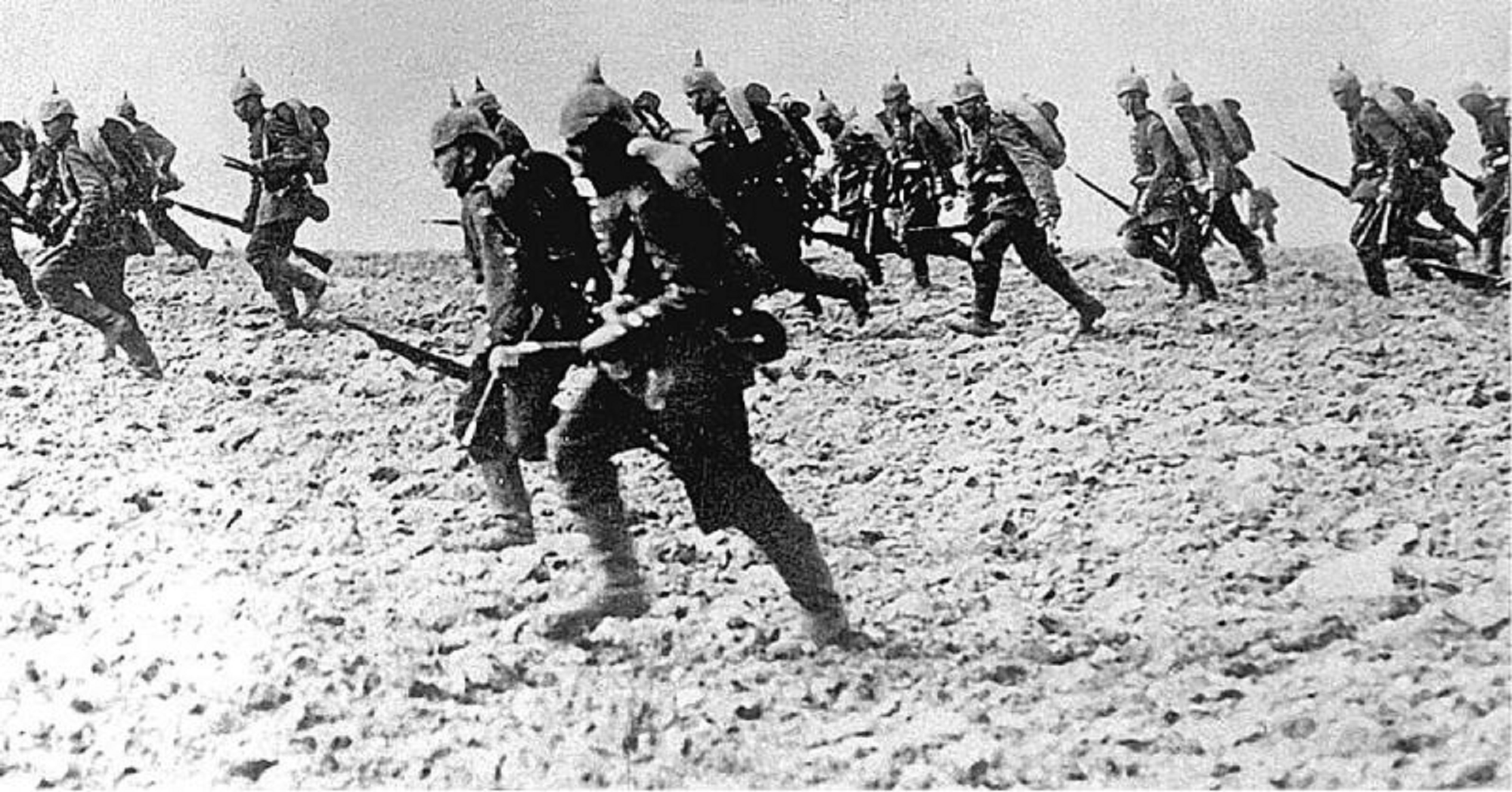


II. Troop Types, Scales, Force Organization, and Basing
V. Unit Status and Combat Effects
IX. Leaders, Command Control, and Regrouping
X. Vehicles and Scenario-Specific Rules
XI. Army Morale and National Organizations
Der Grosse Krieg is a computer-assisted system for miniatures wargames of the early period of the First World War (approximately 1914-1915) at the grand tactical level. Units represent infantry battalions, cavalry regiments, machinegun companies, and artillery batteries, with anything from a brigade to a corps on each side. On the eastern Front, these rules may work for later battles as well, because the fighting remained much more fluid than on the Western Front. Similarly, this may be a useful system for recreating the battles of the Balkan Wars immediately prior to WWI.
The armies of the conflict were massive, and individual battles could go on for days and even weeks, over fronts covering tens of miles. These rules are not intended for the recreation of battles at that scale, but for portraying smaller battles (such as Mons or Le Cateau) or portions of larger, longer battles, covering the front of a division or corps. With more than 20 individual units in a typical division, at this scale of play a corps or two is perhaps as large a force as will easily fit onto a normal gaming table. The play is quick and decisive - rather than using the computer to track the details of each unit, it is focused on providing a fast-paced game which is easy to learn, making it ideal for convention play. Our philosophy is that players should be concerned with fighting the battle, rather than being worried about game mechanics, and that is how we have designed the game system.
The game app will run on any computer or device which has a javascript-enabled web browser. Multiple versions of the software can be run at the same time in a single game. As a computer-assisted miniatures game, Der Grosse Krieg uses a minimalist design. It does not duplicate any of the information which is represented on the tabletop, but functions strictly as a "wargames calculator," replacing the dice-rolling and chart look-ups of other systems. It requires no special pre-game set-up: players must only provide figures, terrain, rulers/tape measures (in inches), and a smart-phone, tablet, or computer which can run the game. Optimized for 15mm/18mm miniatures, other scales can be easily accomodated.
The First World War has long been perceived as a conflict dominated by trench warfare, preceded by a brief-but-transient period of mobile warfare, with some interesting colonial "sideshows." This may be an accurate desription of the Western Front - and indeed, some of the colonial actions are very colorful - but it ignores the much more mobile fighting in the East and in the Balkans. Wargamers today are spoiled for choice when it comes to miniatures: you can purchase figures in many different scales for any era or theatre of the conflict. There is no longer any reason to restrict ourselves to colonial Africa, the Middle East, and the Western Front. These rules are well-suited to fighting the massive and mobile battles in Galicia, the Carpathians, Silesia, and Serbia, as well as the early fighting in the West and in colonial theatres.
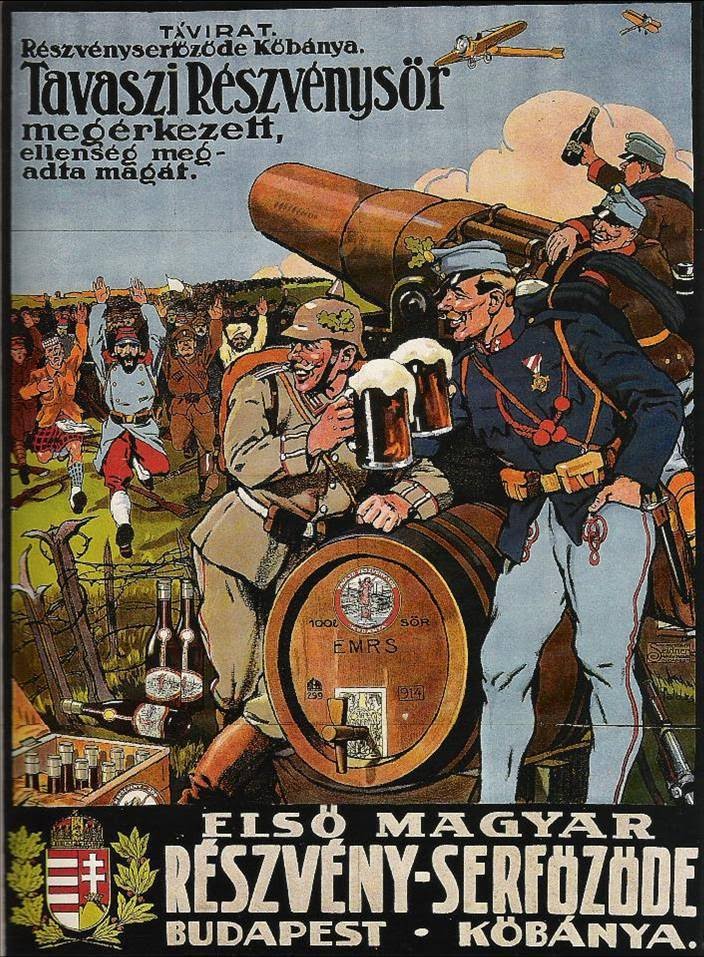
The basic troop types in this game are infantry, cavalry, machine guns, and artillery. Each of these unit types is described below, as well as the representation of generals/leaders, and vehicles and transport of different types.
Infantry: There are three types of infantry in this game: Veteran Infantry, Regular Infantry, and Reservist/Conscript Infantry. Infantry units are normally represented with 4 bases, depicting a battalion-sized unit of around 1000 men (at least on paper), organized into four companies. Veteran Infantry are well-equipped, well-trained, and experienced troops which are not suffering from fatigue or burn-out. Average troops are trained and well-equipped troops. Reservist/Conscript Infantry are second- or third-line troops which are often issued obsolete equipment and are poorly trained. (Note that in many cases, such as the Germans, Landwehr or other reserve troops were as capable as regulars, so "reserve" status does not always translate to this category.)
Cavalry: Like the infantry, cavalry are divided into three categories: Veteran, Regular, and Reservist/Conscript. Cavalry units are represented with 4 to 6 bases representing a regiment of around 600 to 900 men (paper strength), with each base representing a typical squadron. They can be depicted on horseback or dismounted with horse holders as preferred, since they are assumed to mount and dismount as required to carry out their orders (they will maneuver mounted, but will dismount when deployed to fire, etc.) The different categories are similar to those of the infantry in terms of equipment, training, and exerience.
Machine Guns: Machine gun units are represented with a single base, representing a company of 4-6 actual weapons. These were typically available as a company per regiment, and so do not have as ubiquitous a presence as later in the war, although there are exceptions (such as the German Jagers, with a company per battalion).
Artillery: This represents the field and heavy artillery common to the conflict, and these are the two types: Field Artillery (approximately 75nmm to 100mm) and Heavy Artillery (approxinately 100mm and up). Artillery is represented with units of 1-3 bases, depicting 4 to 20 actual guns (each base is around 4-6 guns), and should also include limbers for when the unit is marching or maneuvering (these function as markers). Artillery was not generally used in an indirect-fire capacity in this early stage of the conflict.
Vehicles/Transport: These units represent everything from mule trains to trucks and trains. They are divided into two categories: fast and slow (see below). It is assumed that these units include a modicum of guards acting as their defenders, even though they are not capable of offensive action.
Leaders: The significant Leaders of each army will be present - usually between 3 and 5 for any given force. Each Leader figure will represent the general who commands a corps-, division-, or brigade-sized formation of between 3 and 6 units. Leaders are represented using single, round bases to make them distinct from other units. They cannot be killed in combat and are not themselves targets for game purposes. They function as a way of representing command control on the battlefield.
Markers: Other than artillery limbers. there are only two types of markers are needed for this game: disorder markers and demoralization markers. These can take any form - counters, small round bases with one or two casualty figures on them (one for disorder, two for demoralization), etc. Optionally, markers may be used to indicate which units have already gone this turn (not needed for smaller games, but good for keeping track in larger ones).
Game Scales: There is no figure-to-man ratio for these rules - each base represents men (infantry. cavalry) or weapons (machineguns, artillery) as described above. Each inch represents about 250 yards, giving us a 9-inch mile (for rule-of-thumb layout of the tabletop). Each turn represents an hour of elapsed time. Consequently, combats tend to be decisive in their effects, even though they do not represent continuous combat in most cases, but a shorter period of intense conflict surrounded by other related activities.
Figure Basing: The number of figures in this game is not important per se - casualties and strengths are tracked by base, not by figure. For 15/18mm figures, each infantry or cavalry base will be 1 inch square, with 2 or 3 figures on it. Machine guns and artillery can be based on similar-sized bases, or be made a little deeper to accomodate models. Leaders are single figures or small groups on a circular base 1.5 inches in diameter for brigadiers, 2 inches in diameter for divisional commanders, and 2.5 inches in diameter for corps commanders. Limbers, vehicles, and other markers can be based as needed to fit the models. For 6mm or 10mm miniatures, simply increase the number of figures per base.
For larger figures - 20mm or 25mm/28mm, it is recommended that base sizes and all other measurements be doubled in size. The computer app assumes "standard" distances for 15mm/18mm, for all reported and resulting distances, so these would also need to be doubled during play. (We often play with singly based 28mm, using two figures as the equivalent of a base - this works well for smaller games, but gets annoying when you have too many units.) For smaller figures, use the 15mm/18mm distances and base sizes but increase the number of models/figures per base.
Armies will be organized into brigades, divisions, and corps. During play, each side will make actions with all of the troops in a brigade-level formation, or will employ a divisional or corps commander to act with any of the units under their direct command. The higher-level commanders may also directly command units under the command of their subordinates (that is, they may be within 6 inches and give the the command bonus that involves) but those units will always act at the same time as the rest of the units in their immediate parent formation.
The number of bases in units of any kind may be adjusted to meet the requirements of the scenario being played. It is allowed to have Artillery and Machinegun units with multiple bases, just as it is possible to have more or fewer bases in Infantry and Cavalry units. Given the highly variable strengths of units in the field, this is left up to scenario designers to specify. In general, however, you should not have more than 6 or 8 bases in an Infantry or Cavalry unit, and Machinegun and Artillery units will tend to be smaller than the Infantry and Cavalry units they support. (The limiting factor is how many guns could be used in a coordinated fashion on the battlefield - making a single action, in game terms - in an age of fairly rudimentary communications. We generally play all artillery and machineguns as single-base units.)
The section on "National Organizations" gives a starting point for organizing forces, but be aware that the actual orders of battle in the field could differ from what is presented here. The organizations as given are really offered as a starting point.
The game is played in a series of turns. Each turn, every unit (Infantry, Cavalry, Machineguns, and Artillery) may make one action. These are organized by initiatives: press the initiative button and it will pop up a box giving the initiative to either the Allied Forces or the Central Powers. That side takes an "initiative round": it selects one brigade (or other set of units commanded by a Leader) which has not used its action for the turn, and performs legal actions with all the units and the Leader in that formation. Alternately, a Leader with no units to directly command may move (or choose to hold position). Once one side performs an initiative round, the other side automatically gets the next one. This process is repeated until all units have performed an action, and all Leaders have moved. Players may choose not to use an initiative, but if both sides refuse an initiative in sequence, the turn ends. (This helps stop players from trying to out-wait their opponents.)
Once one side has acted with all of its units and leaders, the other side will act with any remaining units and Leaders in whatever order they choose, until all Leaders and units have made an action during the turn. The entire turn sequence is then repeated.
The application interface is shown below. When a unit acts, the types of the unit, the action it is taking, and other relevant fields are filled in, and the "Result" button is clicked. Needed fields for each action are listed below.
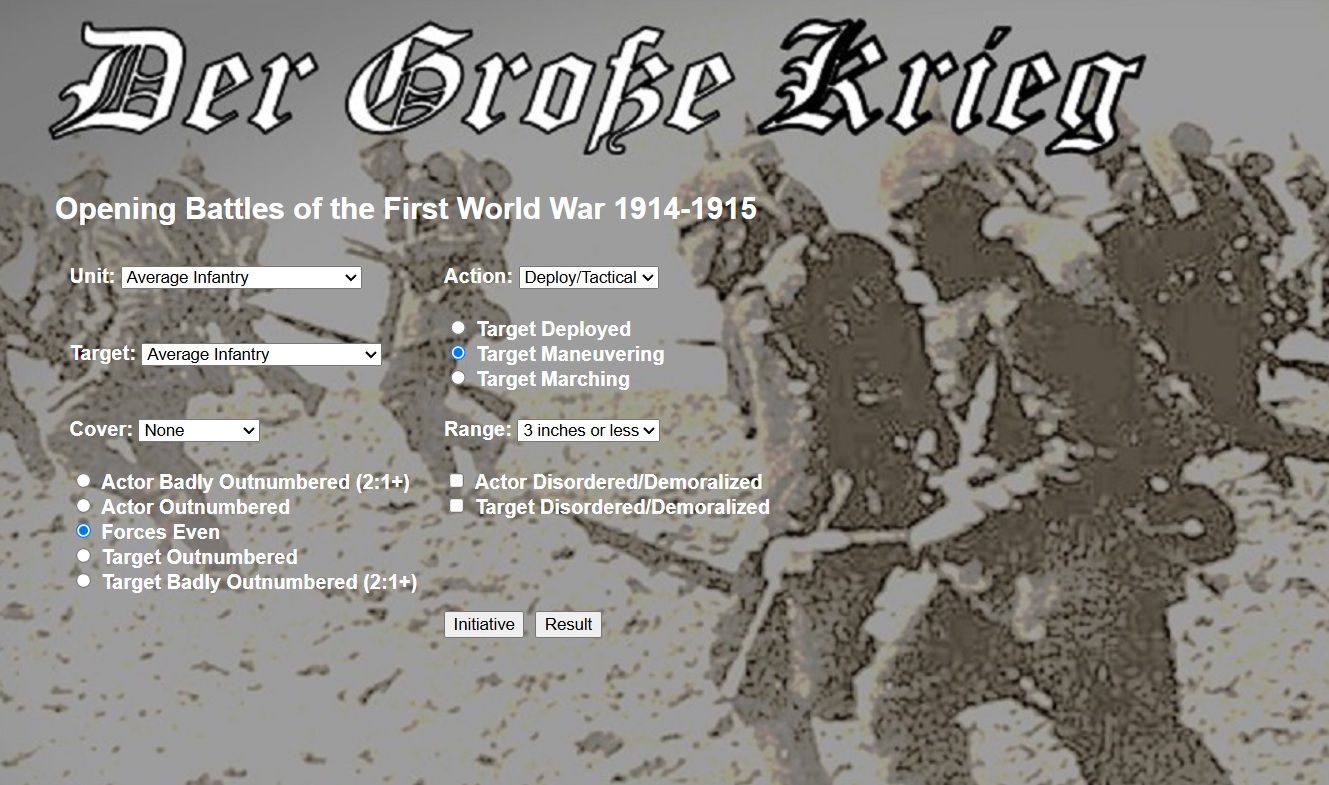
There are several actions available to units, not all of which require the use of the program:
Hold/Rest/Stand: Any unit or Leader may choose to do nothing for a turn as its action. This does not require the use of the program interface.
Move Leader: A Leader may move up to 24 inches base movement, in any direction or combination of directions, subject to normal movement rules (as cavalry). This does not require the use of the program interface. Leaders may only perform two actions: Move Leader and Hold/Rest/Stand.
Deploy/Tactical: This changes a unit into a linear formation, taking advantage of available cover, etc., and prepared to fire. A deployed formation is one base deep, with all bases sharing a facing, side-by-side (they may adjust the front slightly to follow terrain features such as walls). Guns are unlimbered and ready to fire, cavalry are dismounted, etc. When deploying, a unit may shift facing as desired (the center-point of the unit front should not change - see below.) This action also represents tactical movement - the already-deployed unit may move an inch in any direction and alter its facing, taking advantage of cover while doing so. It remains deployed in a single line of bases while doing so. All units may deploy. The program interface must always be used, because there is a chance that transmission of orders may fail or be delayed. Only the Unit and Action fields and the Actor Disordered/Demoralized box need to be used for this action.
Maneuver: This represents the movement of a unit on the battlefield. For Infantry and Cavalry it represents a set of smaller-unit columns, screened by skirmishers. For Machineguns and Artillery, it is limbered movement (or the equivalent) in expectation of imminent action. Fire from a maneuver formation (termed a Moving Fire action) is less effective than that of a deployed formation (termed a Deployed Fire action). Maneuver formations are represented on the tabletop at least two bases deep, and (except for Artillery) at least two bases wide. All bases are placed in edge-to-edge contact, sharing a facing. For artillery, it is a formation only one base wide and two or more bases deep with the bases touching and sharing a facing. When performing a maneuver, facing may be changed as desired (the center-point of the unit front should not change - see below.) All units may maneuver. The program interface must always be used, because there is a chance that transmission of orders may fail or be delayed. Only the Unit and Action fields and the Actor Disordered/Demoralized box need to be used for this action.
Deployed Fire: When a unit is deployed, it may fire. This action cannot be performed by units in a maneuver or march formation. Targets must be within range and arc of fire (see Firing, below). Deployed fire may not involve any facing changes. If the unit performed a Deploy/Tactical action during the turn, it will perform Moving Fire instead of Deployed Fire. The program interface must always be used to calculate the effects of fire. All fields in the app are required for this action.
Moving Fire: Any unit performing a Maneuver action or a Deploy/Tactical action, or already in a maneuver formation may use this action to fire. When combined with other actions, it is always performed by the unit before any movement is done for the turn. Targets must be within range and arc of fire (see Firing, below). Moving fire may involve any facing changes as desired (the center-point of the unit front should not change). The program interface must always be used to calculate the effects of fire. All fields in the app are required for this action.
Assault: This represents a charge into close combat. It may only be performed by Infantry or Cavalry units, and not if they are currently in a March formation. To make an assault, the unit will assume a manuever formation. The target of an assault must be visible to the assaulting unit - facing changes are allowed before an assault is conducted (see Assaults, below). The target of an assault is considered to have used their action for the turn, as well as the acting unit, if close combat ensues (see below). The program interface must always be used to calculate the effects of an assault. All fields in the app except Range are required for this action.
March: This represents the movement of a unit on the march, without the expectation of enemy contact. The unit will assume a march formation, one base wide. For artillery, this also includes a gap between the two bases of a base depth (which can be filled with a limber marker). All bases are placed back-to-front, sharing a facing. The formation may be made in any desired facing (the center point should not change - see below). March columns get a benefit from marching on roads (see Movement, below). Fire and assaults from a march formation are not allowed. All units may march. The program interface must always be used, because there is a chance that transmission of orders may fail or be delayed. Only the Unit and Action fields and the Actor Disordered/Demoralized box need to be used for this action.
Route March: This is a march action made in those scenarios where a unit marches onto the tabletop. They are assumed to have already successfully received their march orders. Base moves are: Irregular Infantry - 10 inches; Average Infantry - 12 inches; Veteran Infantry - 14 inches; Irregular Cavalry - 20 inches; Average Cavalry - 24 inches; Veteran Cavalry - 28 inches; Machine Guns - 12 inches; Artillery - 12 inches; Fast Vehicle/Transport - 16 inches; Slow Vehicle/Transport - 8 inches. The route march ends as soon as the unit performs any other action (with the exception of trains - see below). Scenarios should specify where the marching unit is going on the tabletop. This action does not use the program interface.
Regroup: This represents the reorganization and rallying of troops. The regrouping unit must be disordered or demoralized. If successful, it may assume any formation/facing desired (the center-point of the unit front should not change). All units except generals/leaders (technically not "units") may perform this action. The program interface must always be used, because there is a chance that the regrouping action may fail. Only the Unit and Action fields need to be used for this action.
In most cases, a unit will perform only a single action in a turn. There are some combinations of actions which are permissible, however. A unit which performs a Deploy/Tactical or Maneuver action may also perform a Moving Fire action in that turn, but must determine range, arc of fire, and line of sight before performing any movement in that turn, including facing changes.
It is possible in some scenarios for units to ride as passengers on trains or other vehicles. Such units may not perform movement actions when acting as passengers, other than to change facing or to exit the unmoving vehicle, but are still permitted other valid actions in a turn in which the vehicle itself also performs an action. They are considered to be separate units. Note that Machine Guns and Artillery may be deployed on a train, but that other types of units may not - they will generally be considered to be in a maneuver formation, but may be required by scenario to be in a march formation in cases where they are particularly vulnerable during transit. Artillery and Machine Guns deployed on trains may not perform any movement action other than to change facing or exit the unmoving vehicle (they are set up in prepared emplacements such as sandbags, etc.).
Units which are riding as passengers on vehicles but are situated such that they can perform fire (basically, troops on trains) will use Moving Fire in any turn during which the vehicle performs any kind of movement, or during which they change facing. Artillery and Machine Guns deployed on trains or other vehicles will be permitted to perform Deployed Fire if the vehicle does not move during the turn. Infantry and cavalry may only ever perform Moving Fire from vehicles, as they lack room to spread out properly - they are always considered to be in maneuver or march formation when on vehicles (see above).
An action is taken using the program interface by selecting the correct values for the necessary fields and clicking the Result button. One or more pop-ups will appear, some requiring answers to simple yes-or-no questions ("OK" is yes and "Cancel" is no). The results of the action will be provided in a pop-up, and changes should be made on the tabletop as indicated. A unit which has been the target of one or more Assault actions during a turn may have used its action for the turn, whether it has yet to perform another action or not (see Assaults, below).
Note that units which are disordered or demoralized may perform any valid action, but their performance will suffer accordingly.
If a mistake is made in using the program interface (if a needed field is set incorrectly), ignore the results and repeat the action with the correct values. If for any reason the program interface freezes, crashes, or is accidentally closed, simply re-start (re-open) the program interface and continue. No needed information will have been lost.
Multiple copies of the program interface may be used simultaneously during play. So long as players are in agreement about who is adjuticating what on which copy of the program, there will be no problems. Thus, there is no reason to wait for a single game master to adjudicate everything on one instance of the program. For small games this is not important, but it can help to speed play in larger, multi-player battles.
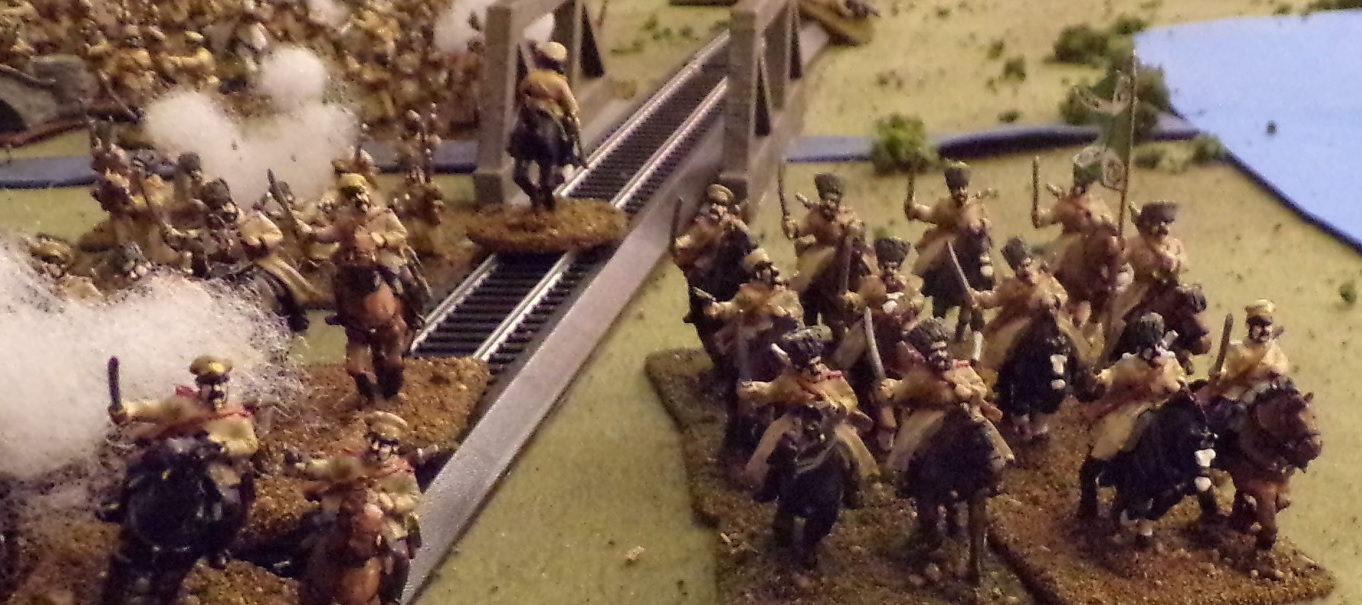
Russian cavalry advance in an action near Lemberg during the Battle of Galicia in 1914. Figures are 25/28mm by Old Glory and Copplestone.
Formations reflect not just the arrangement of troops on the battlefield, but also how vulnerable they are to enemy action. They should not be taken as representing a single line or a deep, close-order column, as that was not the way that troops were trained to fight - or did fight - during the conflict. Each base represents a relatively spread out group of soldiers, and a lot of empty space. Formations also indicate the attitude of troops: are they marching (not a combat formation) or belly-down in the dirt, taking advantage of whatever cover they can?
As described above, there are three different formations in this game. All units except for Leaders will always have a formation (Leaders have no formation). It may be necessary to indicate this on the tabletop using some type of marker, in cases where there are not enough bases in the unit to make this clear (this is often the case for machinegun units). The three formations are shown in the diagrams below (arrows indicate facing), with a description of the rules they should follow:
Maneuver fornation is used for Maneuver actions and Assault actions. It is always at least two bases deep, but may vary in width (Artillery units are the exception here - they should be two bases wide rather than two bases deep when only one option is possible, because the limber markers make it clear what formation is intended). Bases should be arranged in even ranks to the extent possible (no rank may have more bases than the front rank, nor more than one fewer than any other rank in the formation). When possible, it should be more than one base wide. All bases share a facing. When assuming a maneuver formation, any desired facing may be used (center-point of the unit front does not change - see below). When a Maneuver or Assault action is taken, first the maneuver formation is assumed and then the move itself is performed. During this movement, any number of facing changes is permitted - the unit may freely turn as it maneuvers in any desired combination of directions. The movement will end with the unit still in maneuver formation.
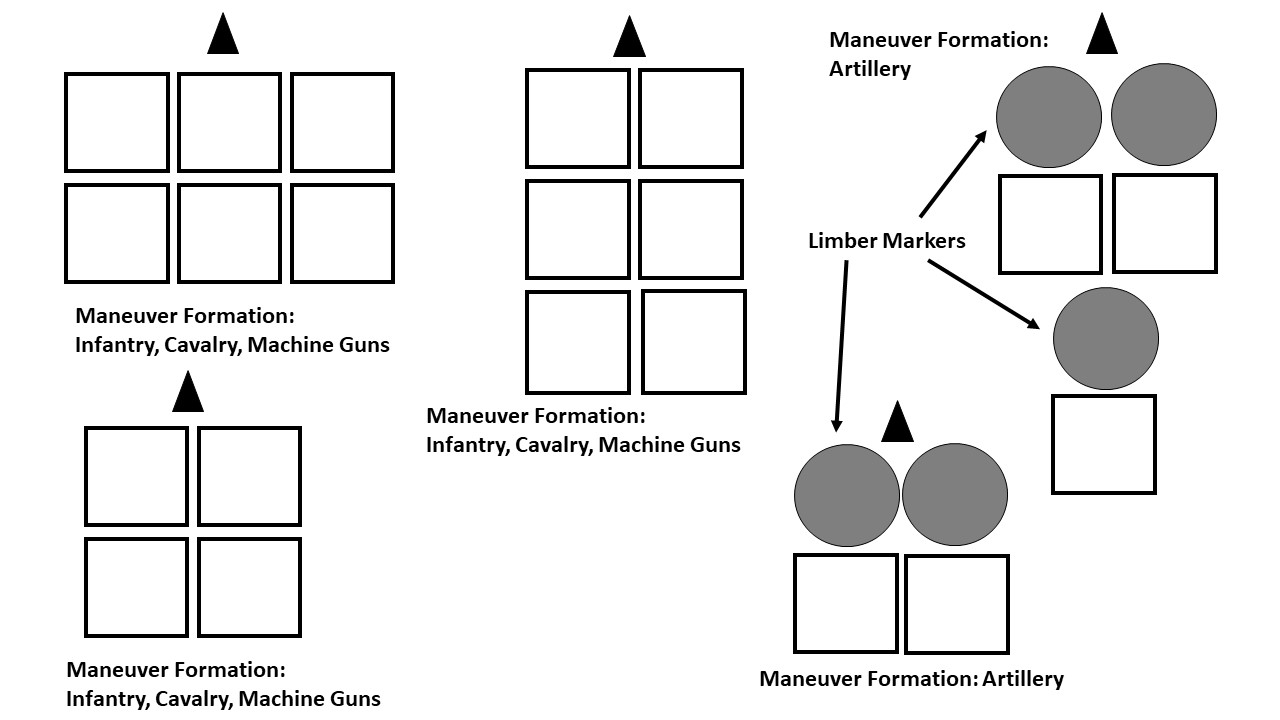
MANEUVER FORMATION - EXAMPLES
The diagram above shows 6-base and 4-base maneuver formations for Infantry, Cavalry, and Machine Guns (although usually you will have fewer bases in Machine Gun units). For artillery, 2-base and 3-base examples are shown. Note that the limber markers are only markers, and do not count as part of the unit for determining range, etc.
All bases sharing a facing, one base deep, arranged side-by-side. The line thus formed is allowed to bend to accomodate terrain features such as a wall, a river bank, a ridge line, etc. Units assume a deployed/tactical formation only by performing a Deploy/Tactical action. Such an action may involve facing changes (the center-point of the unit front does not change - see below). Once deployed, a unit may not move without its formation changing, other than using another Deploy/Tactical action. A unit may not make deployed fire without first assuming a deployed formation.
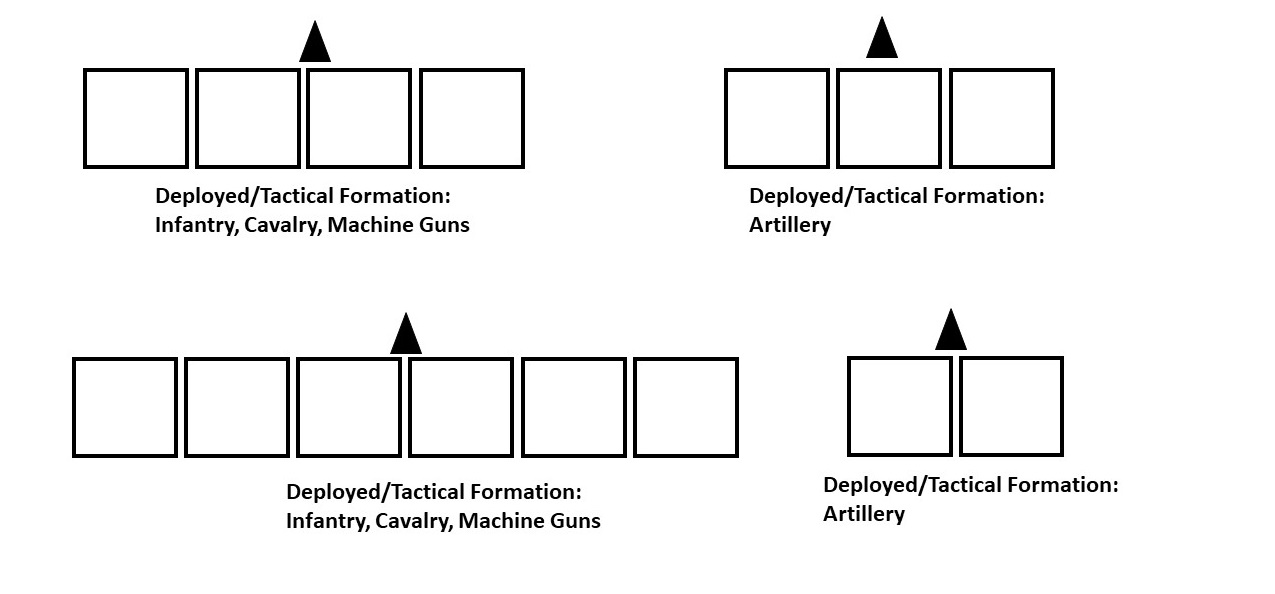
DEPLOYED/TACTICAL FORMATION - EXAMPLES
The examples show the same basic formation for all types - side-by-side in a single rank of bases. Limber markers are not used for artillery.
When a March action is made, the unit will immediately assume the march formation, which is always only one base wide, with the units bases arranged in a front-to-back fashion. The exception is artillery, where gaps are left in the column which equals a single base depth, and filled using limber markers. All bases share a facing. The column may bend ("snake") to follow roads or other terrain features being marched along. When assuming a march formation, any desired facing may be used (center-point of the unit front does not change). When a March action is taken, first the march formation is assumed and then the move itself is performed. During this movement, any number of facing changes is permitted - the unit may freely turn as it marches in any desired combination of directions. The movement will end with the unit still in march formation.
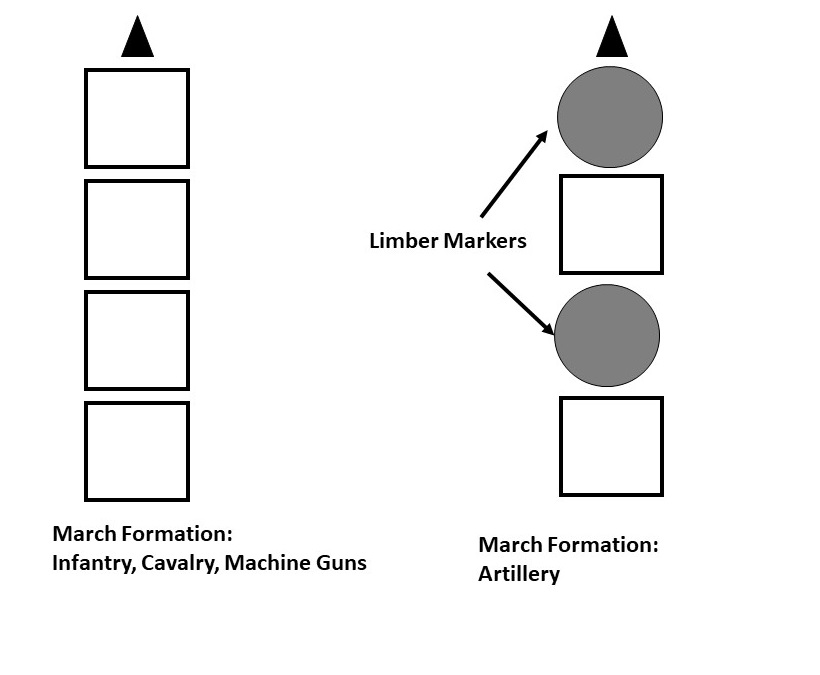
MARCH FORMATION - EXAMPLES
March formation for all types is a single base-width column, closed up, except for artillery which uses limber markers as shown. Note that the limber markers are only markers, and do not count as part of the unit for determining range, etc.
In any case where there are not enough bases in the unit for its formation to be determined by what is seen on the tabletop, a marker or other device should be used to indicate the unit's formation. All units have a formation at all times.
Note that, with the exception of artillery in maneuver or march formation, there is never any gap left between bases.
Note that units which are disordered or demoralized will retain their formation, and simply be marked as disordered or demoralized. Disorder and demoralization do not affect base move distances.
Leaders have neither formation nor facing. Because they are neither targets nor actors in any combat situation, this does not affect game play. When they move, they do so as cavalry with a fixed base movement of 24 inches per turn.
Transport will generally follow the pattern for Infantry, Cavalry, and Machineguns. Often, there are fewer bases in these units, however (similar to Machineguns), and in some cases the nature of Transport (e.g., trains) dictates their tabletop formation. Scenarios should address this if an issue is anticipated.
Changing Facing: There are many actions which allow units to change facing. The diagram below shows how this can be done. The center-point of the unit frontage stays in the same place, and the unit pivots around that point to the desired facing. If this would bring any part of the unit closer to an enemy within 6 inches of its new position, the unit will slide away from the enemy until it is no closer than it was before. The center-point of the unit's frontage - the pivot point - must still be somewhere along the frontage of the unit after this slide away from the enemy is complete.
Note that it is also possible to pivot on the front corners of the unit (or the side/rear corners during sideways or backward movement), paying the distance moved by the opposite corner on the side facing the direction of movement. This is often referred to as a "wheel". This changes facing, but typically not as much as a full facing change performed by pivoting around the center fromt of the unit.
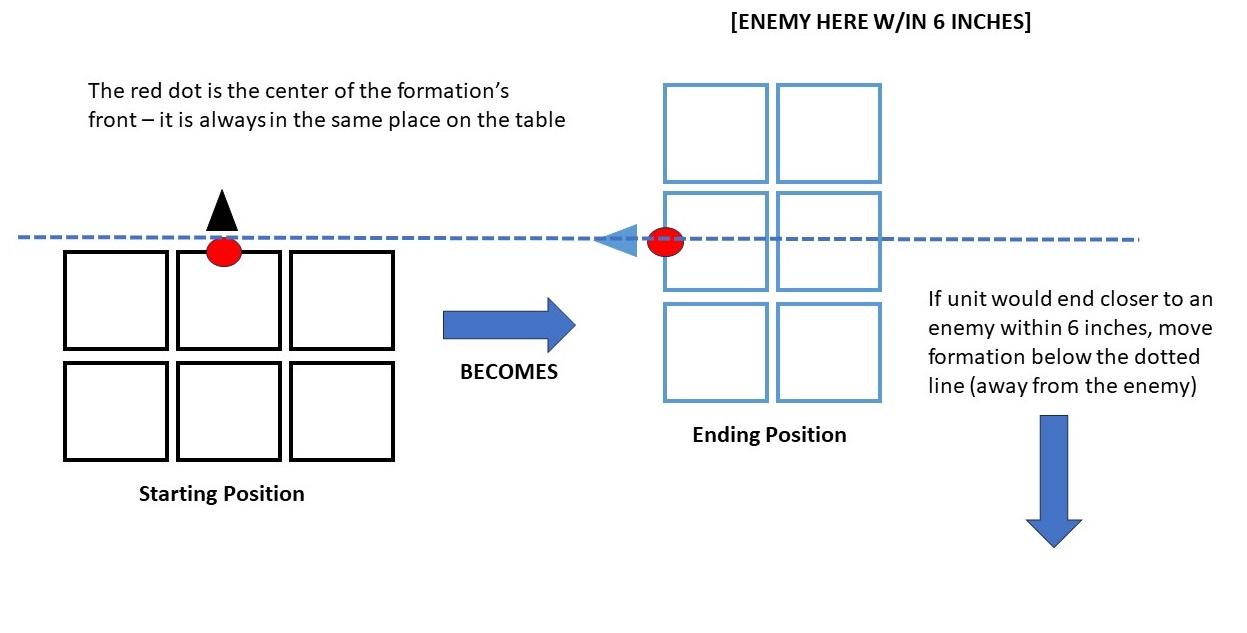
FACING CHANGE - EXAMPLE
A unit in maneuver formation changes facing to the left, by pivoting around the red dot (the center point of its front). If this change of facing would bring any part of the unit closer to the enemy (in this case, off its right flank), and that enemy is within 6 inches after the change of face, then the unit would slide to its left, along its new facing, until it is the same distance away that it was before (the blue dotted line).
Because the models can be quite different for different types of vehicles, it is recommended that scenarios specify how they should be treated, in line with the rules above. Some common cases are covered here.
Trains: Trains are considered to be fast Transport for game purposes. They obviously cannot re-configure themselves on the tabletop, as they will always move along their tracks. Trains count as if in March formation at all times (they are very easy to hit!). Any passengers on trains may have different formations for targeting purposes, however. Artillery and Machine Guns which have been pre-positioned in the train to be able to fire will count as deployed. Infantry and cavalry will generally count as in maneuver formation, with the exception that badly over-loaded trains may place them into march formation, according to scenario rules. This reflects the fact that they cannot shoot through loop holes in the car sides or avail themselves of whatever cover is on offer, as they will be crammed in everywhere. Note that train cars are assumed to provide some level of protection already, so cover modifiers should only be assigned if the train is additionally armored, sandbagged, etc.
Trains are required to make a Maneuver action (as fast Transport) before they are allowed to make a March action. Once moving at "march" speeds, the train is likelwise required to make a Manuever action before coming to a halt. Embarking and disembarking of passengers is only possible if the train is at a standstill - it cannot be done by any unit in a turn in which a train moves. (See below for more rules about trains and other vehicles.)
Trucks and Automobiles: Trucks (and, famously, taxi cabs) were often used by some countries in the Great War, even during the early period. They are classed as fast transport for movement purposes, and should use the same formations as Infantry, Cavalry, and Machine Guns.
Mule Trains and Wagons: Mule trains, wagons, and similar forms of slow transport should use the same formations as Infantry, Cavalry, and Machine Guns.
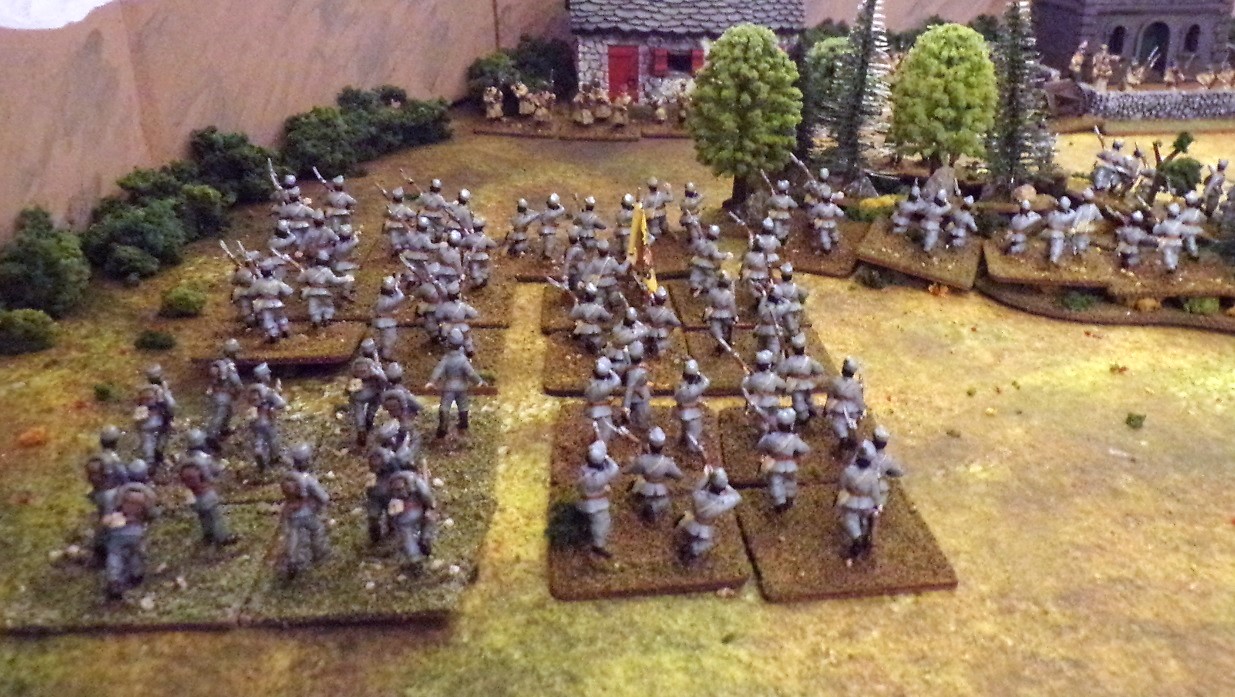
Austro-Hungarian troops swarm toward the Russian lines. (These are 28mm figures from Old Glory and Wee Wolf photographed during a remote game played over Zoom.)
Any portion of a unit's base movement may be spent in an action involving movement (or none of it) but the base movment as adjusted for terrain may never be exceeded. Movement is made in a forward direction along a path specified by the moving player, measuring from the starting location of any base in the front of the formation to its ending location, up to the distance determined by a modified base move. Movement sideways or backward may be made at half speed, choosing a starting point on the side of the unit facing the direction of movement.
Any rough terrain or linear obstacle crossed will adjust base movement: the greatest distance the movement path of any base in the formation spends crossing rough terrain costs twice the movement of crossing open terrain (for infantry or artillery) and four times as much (for cavalry). If I maneuver an infantry unit across 2 inches of open ground, then through 2 inches of woods (rough terrain) it will cost my full 6 inches of base movement (2 inches for open ground, and twice 2 inches for rough). Linear obstacles (hedges, stone walls, etc.) will cost an additional 1/2 inch of movement to cross. Choke-points (bridges, gates through insurmountable walls, etc.) will cost an additional 1/2 inch of movement to cross, unless the unit is in march formation. A maneuvering infantry unit passing over a bridge in open country will move a total of 5 1/2 inches, if it has a 6-inch base movement. Movement inside towns is considered rough for movement purposes unless a unit is in march formation (when it is considered to be road movement). Units in march formation will move 1.5 inches for each inch of base movement when they move along a road/through a town (a 50% movement bonus).
Movement through friendly units is allowed, so long as no part of the moving unit ends its turn "inside" another unit. Enemy units may not be approached closer than 1 inch (their "zone of control") by any part of a moving unit except as part of an assault action (see below).
Falling Back/Pushed Back: Movement caused by combat results (falling back or pushed back) will abide by all normal movement rules. Such movement must be made away from the source of the combat result (the firing or assaulting unit) in as straight a line as possible and within an arc measured 45 degrees off either side of the edge of the affected (moving) unit opposite the direction of fire. The unit being pushed back/falling back will retain its formation and original facing except as required for its movement to be legal (not within 1 inch of enemy units; not through impassable terrain; not moving so as to end up inside another friendly unit; etc.). Although this often involves backward or sideways movement, it is always done at full speed. The diagram below shows an example:
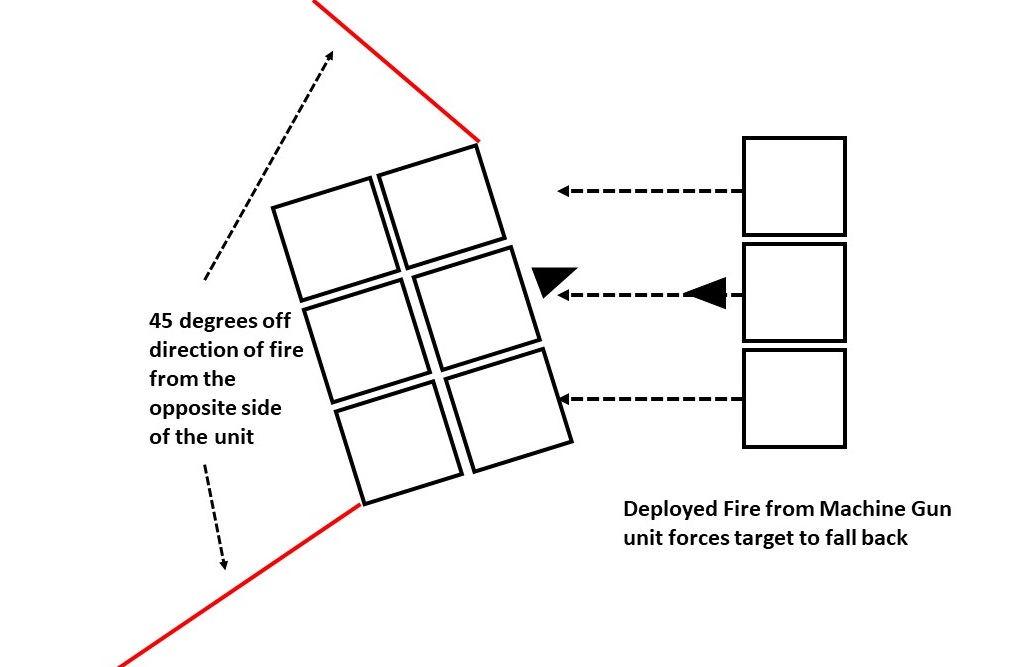
Here, a deployed Machine Gun unit fires on a target, causing it to fall back. The target unit must immediately move to the left within the arc described by the two red lines, a distance of 6 inches, without altering its facing or formation, and would be marked as demoralized, along with suffering any relevant base losses (see below).
When falling back or being pushed back, different types of units will move different distances: Infantry, Machine Guns, and Artillery will move 6 inches; Cavalry will move 12 inches; fast Transport/Vehicles will move 8 inches; and slow Transport/Vehicles will move 4 inches.
Other non-movement-related aspects of combat effects are addressed in the next section.
Other Topics: Making Assault actions also involves movement. This is addressed under Assaults, below.
Note that there is a possibility that actions involving movement (Deploy/Tactical, Maneuver, March, and Assault) will be lost or delayed in transmission. Having a Leader attached to (see below) or within 6 inches of the unit receiving the order helps to prevent this from happening (the Leader is 'on hand' to make sure thing go as planned). When orders are lost, it is still possible to make actions which do not involve movement (fire actions, regroup, etc.). Delayed orders will result in a reduced base movement.
Unit Status: There are three unit statuses: OK, Disordered, and Demoralized. All units begin the game with an OK status, and will retain it until combat effects cause the status to change. Disordered and Demoralized units may make all actions permitted to them when they have OK status, but may perform poorly (the Actor Disordered/Demoralized box must be checked). Regroup actions will allow a unit to recover from Demoralized and Disordered status - you may Regroup whenever you have any status other than OK, but no other actions are permitted in the turn in which you do so. Once fully regrouped, a unit returns to its OK status, as per the app.
Disorder indicates that a unit has suffered some losses, and that it is not responding optimally to command control among and within its units. Demoralization is more severe, indicating further losses and a greater degree of breakdown within the unit.
Disorder makes a unit more vulnerable in combat situations. When firing at or assaulting a disordered unit, the Target Disordered/Demoralized box should always be checked.
Demoralized units behave in the same way, but the higher level of disorganization means that they will not benefit from coherent defensive fire if Assaulted, although they will still fight. (This makes them the ideal candidates for Assaults, especially frontal ones.)
Damage Levels: The damage suffered by a unit is described using "Levels". These are:
Level 1: Unit becomes Disordered
Level 2: Unit becomes Demoralized
Level 3: Unit loses a base and Falls Back
For each additional Level, another base is lost.
Whenever one or more bases are lost, the unit must Fall Back, but only once, regardless of the number of lost bases. (When half the bases in a unit have been removed, it is destroyed and removed from play.)
Levels of damage are additive: if you already Demoralized, and you take an additional level of damage, you lose a base. If you are already Disordered, you become Demoralized. Although you can Regroup to recover from Disorder and Demoralization, Regrouping will never restore lost bases to a unit (once dead you stay dead!). It is possible for a unit to be destroyed as the result of a single enemy combat action. A unit which has already suffered base losses but has subsequently Regrouped will first become Disordered (first Level), then Demoralized (second Level) and only then take additional base losses. When you Regroup, you go back to earlier in the cycle.
In some cases, combat effects will involve involuntary movement (pushed back, thrown back, falling back, etc.). Such movement will be governed by the movement rules described above. In cases where such movement may not be legally completed (i.e., the affected unit is surrounded by enemy units, or is backed up against impassable terrain) the unit will surrender to the enemy - it is considered destroyed and is removed from play. If a combat effect does not specify movement, then the unit will retain its facing and formation in the position it currently occupies.
Losing Bases: Some combat effects involve the loss of one or more bases. This indicates that the unit has sustained severe losses through combat. Lost bases are immediately removed from the affected unit. If at any time a unit loses half or more of the bases with which it started the game, it is considered destroyed and is immediately removed from play.
For both fire actions and assaults, an acting unit or its target may be considered outnumbered or badly outnumbered. This happens in several cases, and is handled as described in the Fire and Assaults sections below. Loss of bases will impact how these conditions are determined.
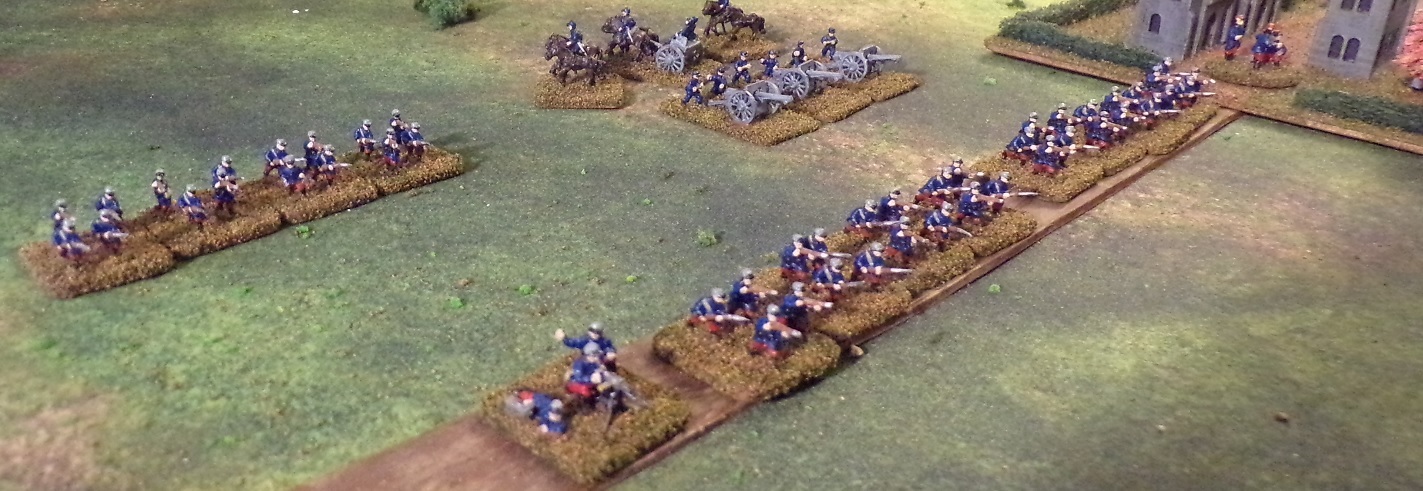
French troops prepared to defend their position in the Battle of the Marne, 1914. Figures are 10mm Pendraken.
Fire actions include Deployed Fire and Moving Fire. Deployed Fire may only be made by units which began the turn in a deployed formation and which are not also making a Deploy/Tactical action in the same turn. Advancing Fire may be made by units in a maneuver formation, or which performed a Deploy/Tactical action during the turn and are in a deployed formation. Deployed Fire is significantly more effective than Moving Fire, because more of the unit is in a position to engage in prolonged fire (in linear formations and/or skirmishing or unlimbered).
Not all units are capable of fire - for Vehicle/Transport units, fire capability is the exception rather than the norm, and they are treated as a special case (see below). Other unit types are capable of fire.
The formation of a target unit is also important for fire actions: when a unit is deployed, it is less vulnerable to fire. When a unit is in maneuver formation, it is more vulnerable to fire. A unit in march formation is the most vulnerable to fire.
The targets of fire actions must be within the range of the firing unit (12 inches for Infantry and Cavalry, 18 inches for Machine Guns, 24 inches for Field Artillery, and 36 inches for Heavy Artillery). The program interface will inform you if you attempt to fire at a target which is out of range. You are allowed to make a different action in this case. Note that pre-measurement is allowed to determine firing range. The range is measured as the closest point between the front of the firing unit (including front corners) and the nearest part of the target unit. (While this does extend the ranges for firing - this extension is historical, reflecting long-range fire and some flexibility in the troops positioning themselves vis-a-vis the target.
Targets of fire must be visible to the firing unit, and they must be within arc of fire. Visibility is determined by a clear line of sight (LOS). Some terrain will block LOS, and some terrain will permit fire over the heads of friendly units under certain conditions (see Terrain, below). Artillery units are always allowed to fire over the heads of friendly units. Visibility into and through woods (and similar terrain) penetrates only 3 inches, limiting fire within woods and scrub and urban environments to this range. Targets of fire must be at least partly within an arc of fire going forward and outward 45 degrees from each of the front corners of the firing unit, as shown in the diagram below:
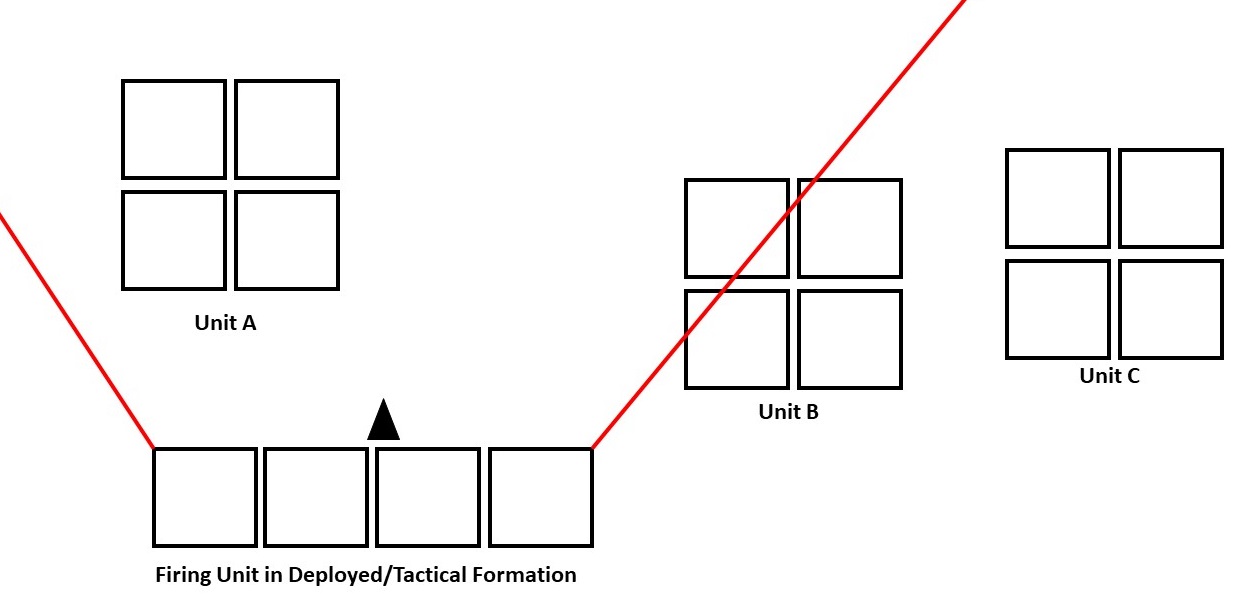
In the diagram, we have a deployed firing unit and can see its firing arc - the area between the red lines. All of the three nearby enemy units (Unit A, Unit B, and Unit C) are within the firing range (although distances are not shown), and there is a clear LOS from the firer to each of them. Unit A is completely inside the firing arc, and is a legal target. Unit B is also a legal target, because it is partially inside the arc of fire. Unit C cannot be fired on, because it is outside of the firing arc.
You are not permitted to fire along a line-of-sight which goes through or closer than half an inch to friendly troops, unless you are firing over their heads (see Terrain, below). This is always the case for artillery fire.
Note that assaults also involve fire combat, but this is computed by the program as part of the assault. It does not require any separate action on the part of players.
Whenever the firing unit has more or fewer bases than the target unit, then the Outnumbered boxes must be used. All bases in both units are counted, regardless of whether they individually have LOS, etc. Check the "Actor Outnumbered" box if there are more bases in the target unit than in the firing unit; if there are twice as many or more, instead check "Actor Badly Outnumbered". Check the "Target Outnumbered" box if there are more bases in the firing unit than in the target unit; if there are twice as many or more, check "Target Badly Outnumbered". If the firer and target are equal in number of bases, the "Forces Even" box should be checked.
The effects of fire are described in the sections above.
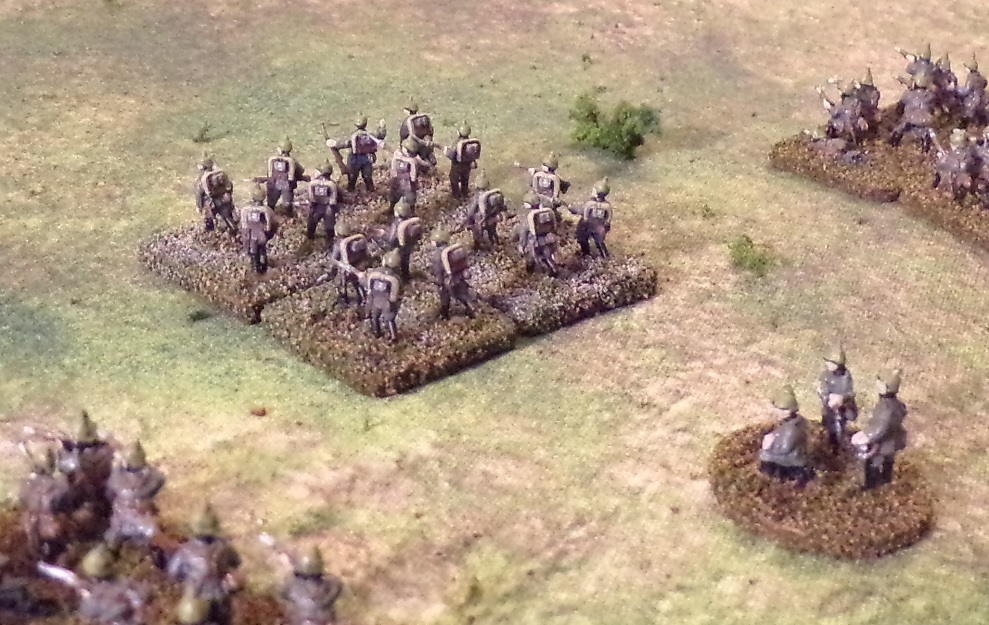
German infantry advancing to the asssault. Figures are 10mm by Van Dyck, surrounded by their comrades from Kallistra. The detail on the Van Dyck figures is incredible for 10mm!
Infantry and Cavalry units starting the turn in maneuver or deployed/tactical formation may make Assault actions. This represents the close-range fire and hand-to-hand combat which was a common occurrence during the conflict. The biggest danger to an assaulting unit is the defensive fire which is likely to be made by a defender. This can be mitigated by choosing a target unit which is disordered and by not making a frontal assault (that is, an Assault through the target's arc of fire). Even so, Assaults can be dangerous. Best is to Assault a unit which is demoralized - demoralized units will fight but do not organize coherent defensive fire against a charging opponent. Targets in march formation are also a good choice. Cavalry is excellent at close-quarters fighting in open terrain, although not so good when attacking in rough or against trenches or fortifications.
When making an Assault action, there must be a clear LOS to the target unit and it must be at least partially within the firing arc of the assaulting unit after an initial facing change or wheel. The target of an Assault must be within 6 inches (base movement) for assaulting Infantry units and 12 inches (base movement) for assaulting Cavalry units. These distances are modified by terrain just as movement is, made along a straight path between the center front of the assaulting unit and the nearest part of the target unit (the "assault path"). The target unit must be at least partially within the modified distance. For Assaults where orders are delayed, the same process is used but the distance is reduced, as indicated by the program interface. A frontal Assault is any Assault which crosses the firing arc of the target unit, as determined by the assault path between the two units.
Assaults may not "go home" - that is, the assaulting unit may be stopped by fire before making contact with the target unit. Any Assault action in which the assaulting unit is forced back to its starting position is a charge which has not "gone home." In this case, the assaulting unit will have used its action for the turn, but the target unit - if it has not already acted for the turn - may still make an action. If a charge goes home - that is, defensive fire does not push it back to its starting position - then both the assaulting and target units have used their actions for the turn (they are occupied by the close combat and its aftermath). In this case, the assaulting unit is moved along the assault path into contact with the target unit of the Assault, before any combat effects take place (which might push the target unit back). Note that in cases where the Assault goes home but is defeated in close combat, the assaulting unit may not actually need to be moved (e.g., it moved forward 6 inches into contact and was pushed back 6 inches). Notionally it still moves, however.
The Outnumbered check boxes are used slightly differently in assaults than they are for fire. In an Assault, the target is outnumbered if the total number of bases of all units which have assaulted the target that turn, at the time they made the assault, are greater than the number of bases in the target unit. To give an example: I have a Veteran Infantry unit of four bases which is assaulted by an Average Infantry unit of four bases. Neither actor nor target is outnumbered for this action - both have four bases. If there is another assault during the turn on the same target unit, all four of the bases from the first assault are counted (even if the first assaulting unit lost bases as a combat result) when calculating outnumbering for the second Assault. Thus, a second Assault made by a three-base Average Infantry unit would outnumber the four-base target unit, because it adds the number of bases of the first assault (4) to its own number of bases (3) to get 7, which outnumbers the target unit's 4 bases. A third Assault during the same turn would add all 7 of the bases from the preceding assaults to its own total.
Unlike fire, the combat effects of Assault actions may affect either or both of the participants. These effects are described in the preceding sections.
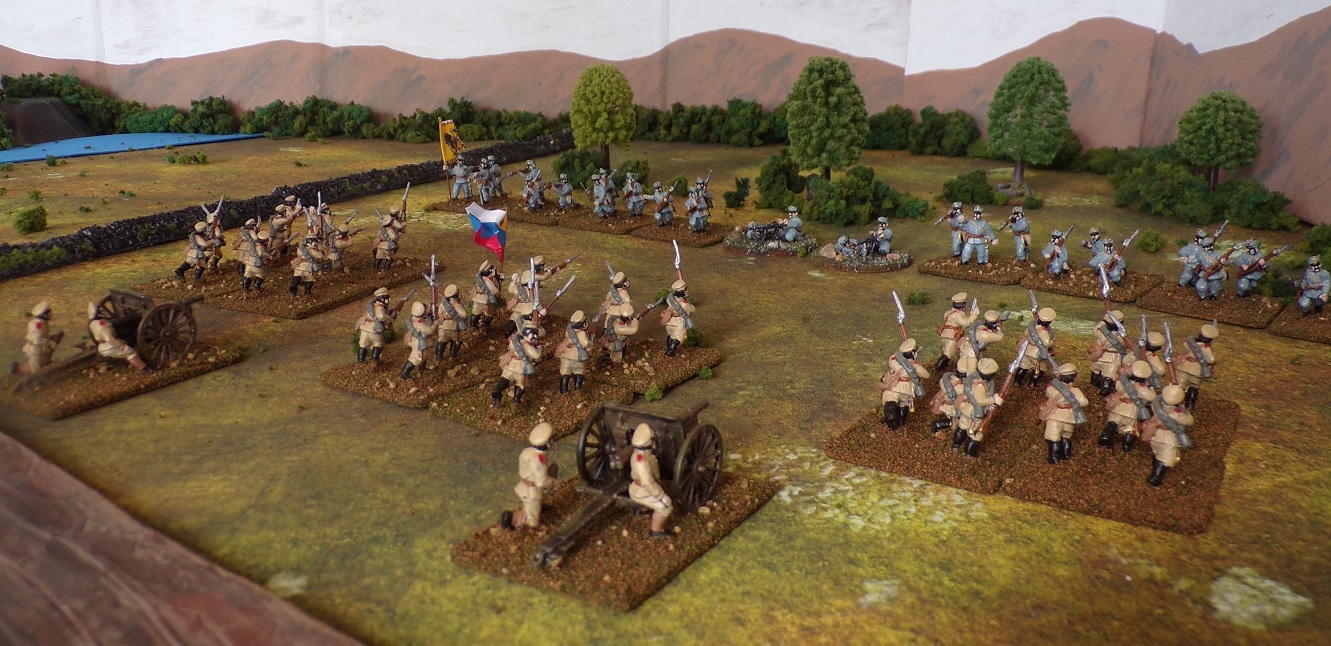
The assault goes in! 25/28mm figures by Old Glory and Copplestone.
Terrain can have a huge effect on play, influencing movement and providing cover. Terrain may also permit or stop potential fire and Assault actions by blocking the line of sight (LOS). Scenarios should specify the characteristics of all tabletop terrain before play begins.
Movement: There are several types of terrain from a movement perspective: open terrain, rough terrain, impassable terrain, roads, linear obstacles, and choke-points. Open terrain is typically fields - ground which does not impede movement. Rough terrain can be woods, swamps/marshland, rocky hills, or similar types of features. It slows movement by half for Infantry, Machine Guns, slow Vehicles/Transport, and Artillery and by three-quarters for fast Vehicles/Transport, Cavalry, and Leaders. Impassable terrain cannot be entered or crossed - it consists of such things as cliffs, deep swamps, and unfordable rivers. Roads are "improved" roads, and not just dirt tracks. They speed the movement of marching units by half. Linear obstacles are walls, hedges, and other obstacles that must sometimes be crossed. They will cost a penalty of a half inch off of base movement for units which cross them (note that, while individual mounted horsemen can easily jump some linear obstacles, entire mounted formations generally cannot!) Choke points are bridges, gates through otherwise impassable walls, and similar points where movement is contstricted. These cost a half inch of base movement to pass, unless the unit is marching. Note that many such choke-points are also roads (bridges, for example). Towns are a special category of terrain. For units marching, they act as roads. For other formations and types of movement, they count as rough. The exception here will be open plazas found in the center of many towns - these could be considered open.
Cover: Terrain can also provide cover for fire and combat purposes. Open terrain does not provide cover, nor does the type of rough terrain (such as swampy ground) where there is not much above ground level to provide protection from prying eyes or bullets. Fords across rivers are an excellent example - they impede movement, but do not conceal or protect those crossing them. Soft cover is that type of cover which serves to conceal troops - the typical example is woods or scrub brush. During this conflict, most fire was aimed fire, and it assumed that the target was visible to those firing. Although later during the Great War area fire with machineguns or artillery fire onto a set of map coordinates became commonplace, this was not typically the case during the early years of the conflict. Other types of cover also act as soft cover: villages may consist of structures made of softer materials which will not stop bullets (wooden barns/houses/sheds); and many types of hedges and fences will conceal but not provide the degree of cover which will stop a bullet or shell. Hard cover includes stone walls, the solid buildings of stone or brick found in towns, and naturally protective "soft" areas which have been fortified (fortified villages, for example). It also includes prepared trenches. Fortifications include redoubts and fortresses - places where engineers have designed and built military fortifications.
Line of Sight (LOS): Terrain also acts to obstruct line-of-sight. To determine LOS, a line must be drawn from any point on a base of the spotting unit to any point on a base of the unit being spotted. Ranges for fire in this game are calculated as the shortest clear LOS between the front of the firing unit and its target (round down if they are on a break-point measurement such as 3, 6, or 12 inches). If the potential LOS crosses any terrain, it may be blocked. There are rules for determining what can and cannot be seen.
Woods and scrub, or other tall obstructions can be seen into up to 3 inches. This includes the edges of towns, which in this scale have single buildings representing clusters of actual structures, which may allow some visibility. After 3 inches, visibility is absolutely blocked.
For this purpose, terrain is classed according to a series of levels: ground level, low obstructions (hedges, walls, wheatfields, etc.), taller obstructions (houses, woods), low hills, taller hills, even taller hills (etc.) - each level of hill is a "terrain level." Terrain in all of these different height categories may be found on the tabletop. The rule for LOS is that if you can see them, they can see you - it works in both directions. Low obstructions may provide soft or hard cover to troops immediately behind them, but do not block LOS. Taller obstructions such as houses and woods will block line of sight across the same terrain level, but may not block LOS from higher levels, according to a more complicated system: at one terrain level up, your LOS will not be blocked if tall obstructions are closer to you than they are to the target. For each terrain level you go up, half of the area blocked from the level below becomes visible. See the following diagram:
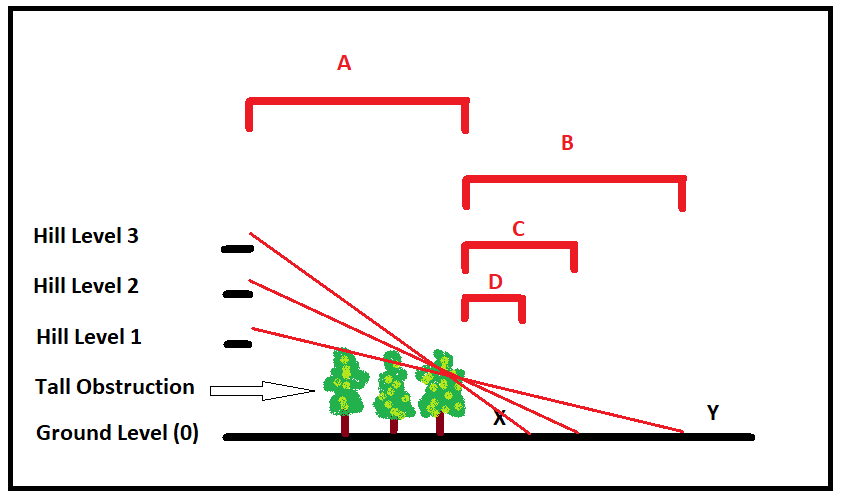
For aesthetic reasons, our figures and terrain pieces are not in agreement with the ground scale. Thus, what we see on the table is not how it really is. This system gives you a way of approximating reality. (Short of going and surveying critical vistas on the battlefield, or having a really good 3-D model, you won't get better than an approximation. There are wargamers who have visited and surveyed important battlefields, but from a practical perspective this is not an option for most of us.) In the diagram, we have hills on the table up to 3 terrain levels tall. We also have a tall obstruction (woods).
If you have more than one tall obstruction between you and the target you want to spot from above, and the obstructions are on the same terrain level below you, always check the one closest to the target. If that one isn't a problem, none of the others will be. Note that model hills for wargames are often stepped, to allow figures to stand on them at different levels. Often, these are meant to represent sloping hills rather than a series of stepped plateaus. The scenario should specify the nature of hills, so they are interpreted correctly during play.
The same system is applied to firing over the heads of friendly units. Treat the friendly units as a tall obstruction: if the target would be visible (according to LOS rules) then you are allowed to fire on it.
This may seem a little complicated, but it is important to any simulation of combat, where terrain played a significant role in the outcomes of many battles. Once you get used to it, it starts to become obvious.
Leaders have several critical functions in this game, even though they do not perform actions or serve as targets like units do. The first is to help guarantee that orders are received and obeyed without delay. They do this by being within 6 inches of the unit being given the order when the action starts. Fire actions will be taken without a problem, as troops need no orders from higher-ups to fire on the enemy.
Another function of generals is to help regroup disordered and demoralized units. Again, they do this by being within 6 inches of the unit which is regrouping.
Leaders may only influence units which they command. This means that the unit must belong to a formation that Leader commands, at any level in the chain of command, or the leader must be the "commander in chief" of the army, who is allowed to command any unit in the player force.
Each turn, when activated, the Leader and all of the units within that Leader's command may make an action. Leaders - although not "units" per se, are also allowed to make an action. They are only allowed to move once during the turn.
Generals cannot make any combat actions, nor may they be the target of combat actions. Their only actions are to move and to rest. They influence their troops via their proximity. Note that they may issue orders to units, move, and then issue more orders to units, thus infuencing a larger number of units through proximity than if they had not moved. This is legal according to the rules.
A Leader who would be "run over" by the enemy simply moves out of the way, until 6 inches away from any opponents. This is a free move, which does not impact any other movement they make during the turn.
The Great War saw the large-scale use of many mechanical contraptions in combat for the first time: trucks were used on a fairly large scale, and airplanes were employed, as were some armored cars. In some cases this was not at a scale where they really have a place in a grand-tactical game such as this. Players may wish to include them, however, depending on the scenario and historical example, so we provide some guidance about how they can be included.
Trains were a major feature of the conflict, but were mostly not used in combat setttings. There are, however, some exceptions, so we will provide rules for trains, including the use of armored trains, which sometimes did appear on the battlefield during fighting.
Some other aspects of the fighting which became very typical of the later conflict may be included in specific scenarios. On this list are barbed wire, mine fields, and indirect artillery fire. We will suggest some ways to include these in the game.
Scenarios should specify what the carrying capacity of any given vehicle unit is, if any. Passenger units may not embark or debark from vehicles in any turn in which the vehicle moves. Embarking and debarking only require that the passenger unit ends/starts its movement in contact with the carrying vehicle. For trains, we generally allow a unit plus a Leader per train car, with each train car counting as a base. For trucks and cars, we use a car model per vehicle base. In both cases, we assume that the vehicles are not being employed to carry cargo or otherwise occupied.
Trains were a major factor in the strategic manuevers during the Great War, and in some cases appeared on the battlefield. While trains on the Western Front are mostly known for being used to carry the heaviest of artillery later in the war, they were a primary means of conducting troop movements, and were central to supply networks. On the Easern Front, armored trains were a common feature, and saw action in some of the battles there. In the East, most of the major combatants (Germans, Russians, and Austro-Hungarians) used armored trains, including as support for infantry and to conduct reconnaisance missions.
As noted above, trains are always considered to be in march formation when being targeted, as they are easy to hit. Units riding on trains are considered to be separate targets. Each car of a train is considered a base, but bases are not removed from play when destroyed, they are just marked until the entire train is destroyed (half of the cars/bases). If a train is destroyed, all units riding on it will take 1 level of damage and be immediately disembarked. The destroyed train will block the track where it has ended up. (Troops on trains were very alert to the potential dangers of this form of travel, so we assume that they will do whatever they can to minimize the impact of the train's destruction.)
Trains are considered to be fast Transport for game purposes. Trains moving from a standstill must make a maneuver action before they are allowed to make a March action. Likewise, they must perform a maneuver action after making a March action before coming to a halt. Trains may not switch direction until they have come to a halt. At least half of the base movement must be used. The only terrain which will affect train movement is a steep slope, which will slow it by half. Anything which cannot be easily brushed aside by the train will block the track, and cause the train to stop. If the train is derailed (by destroyed track or explosions set off underneath it) then it is also destroyed, with effects on passengers as above. The ability to rip up track and blow trains up should be specified by scenario. but it is suggested that these activities require a lot of preparation - they were not typically conducted under fire during battlefield conditions. That said, a group of 50 men could easily rip up a stretch of track in a half hour, sufficient to derail a train, if they were not under fire. You can use a "Rest" action to represent this in game terms, if you want to allow it, with the destroying unit in contact with the track while ripping it up. We recommend not allowing track to be ripped up by units under fire or being Assaulted, or units which are disordered or demoralized.
Players may wish to ignore any delayed or lost orders with trains. While these could be "explained away" as technical difficulties, it is recommended that scenarios specify what happens when a train has these issues. Simplest is to merely retry the action until it succeeds normally.
A regular train does not provide cover, but if it has been lightly armored (fitted with sandbags and other ad-hoc armor) it will provide hard cover both to itself and to any units travelling as passengers on it. A train which has been constructed or refitted as a dedicated armored train will act as a fortification against fire on it or its passengers.
Machine Gun and Artillery units deployed on trains (required to be specified at the start of the scenario) will always make Moving Fire if the train on which they are emplaced has moved, and other units will always conduct Moving Fire (deployment on trains is not allowed for infantry and cavalry units). Units emplaced on trains or being carried as passengers are assumed to be able to target anything out any side of the train which is not obscured by another car in the train, regardless of the facing of the models. Trains and passenger units on trains which are required to Fall Back will ignore this result, remaining in place. Moving trains cannot be Assaulted except by Cavalry units, and are accorded Soft Cover modifiers to reflect the difficulty of this type of attack. Even this is not permitted if the train is making a March action during the turn. While passenger units may be Assaulted at any point on the train where they are positioned, the locomotive must be Assaulted if the target is the train itself. A unit is not allowed to perform an Assault in a turn during which it detrains.
Many different types of automobiles were used during the Great War, albeit mainly as supply vehicles and to transport higher command staff. We allow also for them to be used as troop transports, and account for the deployment of armored cars. There are two basic types: trucks and cars. Trucks are considered slow Transport, and cars are considered fast Transport. Like other unit types and unlike trains - these models will represent more than one vehicle per base, unless specified otherwise by scenario. Even so, their carrying capacity is limited. Typically we allow 2 passenger bases of Infantry or Machineguns to be carried by a car base, and 4 by a truck base. Artillery and Cavalry requires twice as much transport.
When firing at these vehicles, they are assumed always to be in Manuever or March formation (they are not allowed to deploy, being too bulky and easy to target). As with trains, when an automobile base is destroyed, it passengers are disordered and immediately debussed adjacent to the now-defunct vehicle. The unit of which the passenger bases are part will suffer the disordered status, even though some of it may be in other vehicles. Automobiles provide no cover to passengers, which are always assumed to be in Maneuver formation when targeted.
Fire from vehicles is limited: it is always Moving Fire, and artillery fire is not allowed. We suggest that you make scenario rules regarding the use of Machineguns from automobiles, as it is not unreasonable to disallow this unless the MGs are specifically mounted for this purpose.
Armored Cars: There was some use of armored cars during the early war years. If you wish to field these, they are essentially cars (fast Transport) which have an inherent Hard Cover property (they get the Hard Cover modifier even when in the open, and are considered Fortified when hull-down, but only against fire, not Assaults). They cannot carry passengers. When they fire, they will fire as Machinegun bases. They will react to Assaults also as Machinegun bases in Hard Cover. Note that because these are formations of a half dozen vehicles, they will have a unit frontage like anything else, even though individual vehicles may have all-around turrets.
Aside from reconnaissance, aircraft did not play a major role in the early war years. Despite this, they cannot be entirely ignored. The rules here are provided for those who wish to include them in the game - they are undeniably colorful and fun, even if their inclusion sometimes may not be historically justified.
Planes start off-table. They will move on-table as a Maneuver action, appearing at any point where the player desires. Each turn, they make make a further on-table Maneuver to any point, but if they need to perform a bombing run, they need to be placed immediately adjacent to the target of their attack. Before the bombing attack takes place, any unit capable of anti-aircraft fire (rare, but such units did exist historically, especially around airfields, ports, and similar places) may perform a Deployed Fire action versus the aircraft (a Vehicle/Transport in Maneuver formation), without cover modifications. (This is true even if the AA-equipped unit has already acted for the turn.) If the aircraft is destroyed (e.g., 3 levels of damage) the bombing run does not take place. If it is disordered or demoralized, the appropriate modifiers will be applied to the bombing run. The bombing run itself is conducted as Deployed Fire from an Artillery unit at a range of 3-6 inches. Targets will benefit from cover as appropriate. Once the bombing run is complete, the aircraft is removed from the table - it must spend 3 turns off-table before it can re-appear to conduct another attack (this can be adjusted by scenario). Note that planes are only vulnerable to fire when they are conducting a bombing run (or other ground-related activity as per scenario) when they are flying at low altitude. Normal units may not fire on them, not being effectively equipped to do so. There is no provision for interceptors or air-to-air combat.
In cases where aircraft had the ability to strafe ground targets, the bombing run as above would instead be replaced by equivalent fire from Machine Guns. If an aircraft is capable of more than one attack, it may stay on table unless disordered or demoralized, in which case it returns to base for repairs. No more than one of each type of attack (bombing, strafing) is allowed for any single air sortie.
The use of barbed wire became extremely common during the course of the Great War and does feature in some of the early actions. Mines were typically used in their 19th-century form, as explosive siege works designed to break through enemy fortifications. There were some cases of pressure-triggered anti-personnel mines early in the war, however, although not many. Barbed wire should be represented on the tabletop, preferably in segments of a couple of inches which can be removed when they are cut. Units may not cross barbed wire easily. To cross barbed wire, a unit must spend a turn in contact with it, performing a Rest action. On the completion of this action, the segment of wire with which the unit is in contact will be removed. Artillery will not cut barbed wire (shrapnel air-bursts) - it must be done manually. It has the effect of making an advancing enemy tarry in the kill zone longer, which was its basic function.
Mine fields require that hidden deployment be used, preferably with a game master and a good map. When a unit enters a mine field, it immediately stops and takes one level of damage. The mine field is then placed on the tabletop. Each turn spent moving through a mine field will incur a single level of damage. If extensive mine fields are deployed, they should be arranged in 2-inch squares, which would be revealed only one at a time as encountered.
For large-scale explosive mines triggered on command (as opposed to land mines) these can also be plotted as single points on the tabletop. When triggered, they will explode like a Deployed Fire from an Artillery unit on every unit within 3 inches. Cover modifiers should be used as with normal artillery fire. Further, any fortifications within the blast radius will be reduced to Hard Cover. Such things were used during the early stages of the Great War, but not very often.
Artillery units during the early months of the Great War had often been trained in indirect fire tactics, but did not necessarily practice them in the field. Part of the reason for this was that, in the more fluid situation faced by the antagonists, ther ability to spot the fall of shot was very limited, often to the operators of the batteries themselves. (You often see the use of ladders rising from among caissons or attached to hay ricks, etc. to extend the view from the position of the battery itself.) To reflect this, the basic rule is that, while artillery can fire over intervening troops, it cannot fire into places where the battery itself lacks visibility. There were some exceptions, however. If you wish to include indirect fire, you can use the following: it is only permitted to be performed by deployed Artillery units. The targets for such fire must be known to the firer (you can specify spotting rules by scenario, but it was generally the case that emplaced artillery had good communications with their high command, so we allow any friendly unit to spot for their artillery).
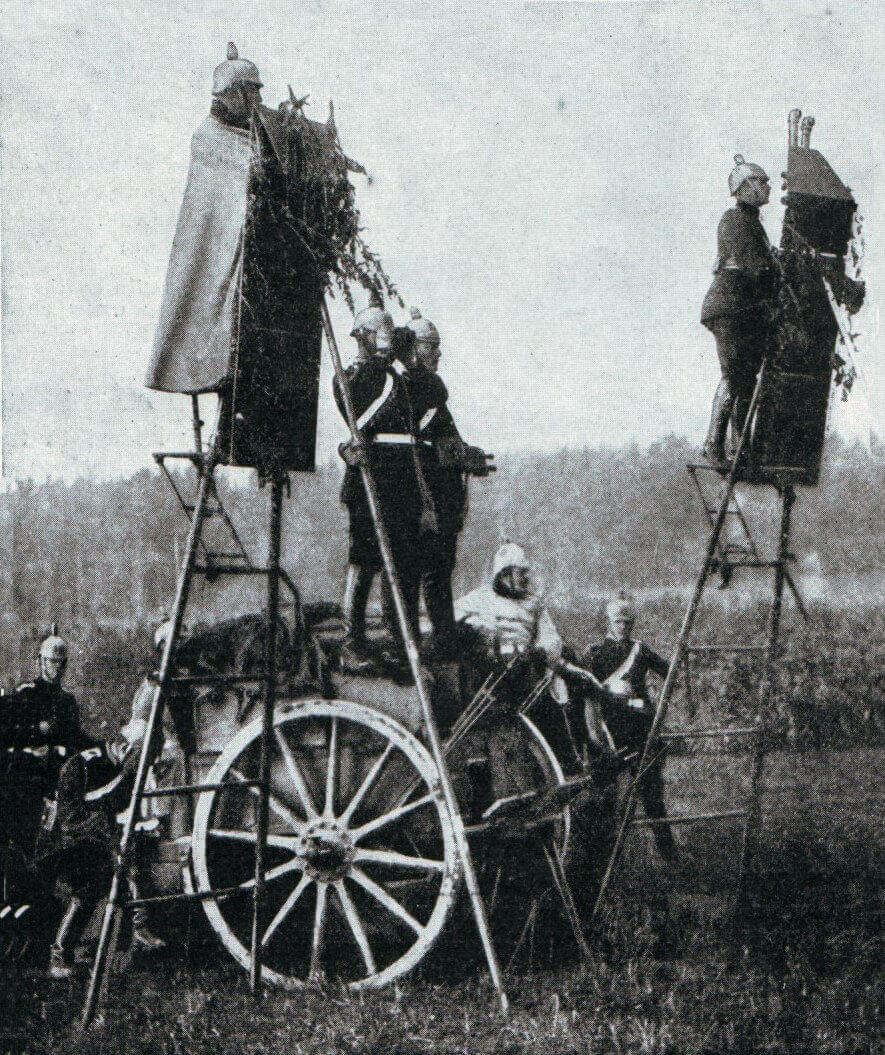
German artillery spotters on ladders. There were some technological advances waiting in the near future!
Indirect fire ignores normal LOS rules, although significant barriers such as hills more than a single terrain level tall will block it. Instead of making a Deployed Fire action, indirect fire is always done with a Moving Fire action. Any measured range of more than 12 inches is divided in half, allowing guns to fire out to 48 inches.
It is fun to provide for hidden deployment in games which include indirect artillery fire: once a unit moves or fires it can be seen and targeted, but not before. In some of the battles during 1914 and later, this type of concealed deployment was a significant factor.
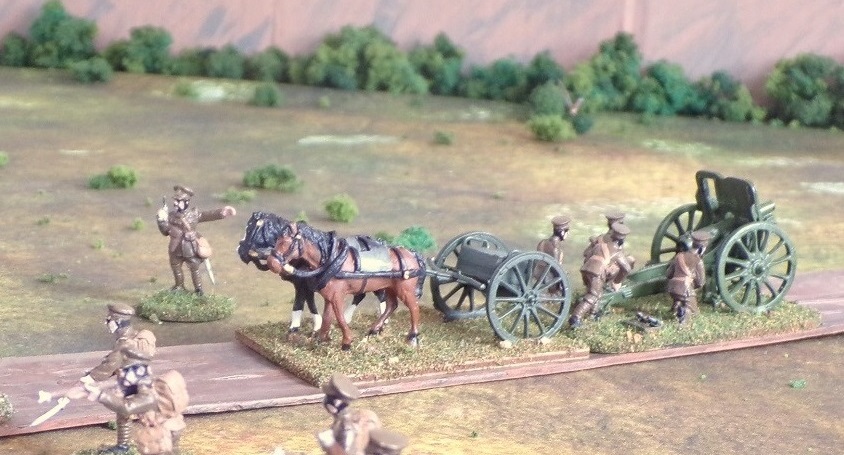
A battery of British howitzers unlimbers. Figures are 28mm by Empress and Tiger.
Army morale determines when an army has been beaten, and will stop fighting, conceding the battle. Scenario victory conditions may choose to ignore army morale, but should provide alternate victory conditions if they do so. By default, breaking your opponent's army by destroying its army morale is the way to win.
At the start of play, a break point is calculated for each army. This is done by counting up the number of combat units (not including Leaders or Vehicle/Transport units which are incapable of offensive action), and taking a percentage of this total based on the quality of the army. Army quality should be set by scenario. For unmotivated armies, the percentage is 40 (multiply by .4 and round up). For average armies, the percenatge is 50 (multiply by .5 and round up). For motivated or desperate armies, the percentage is 60 (multiply by .6 and round up). In every case, the result should be rounded up to the next highest whole number. This is the army break point.
During play, for each unit destroyed, including Transport units, subtract 1 from the army break point. Scenarios may also assign a supply dump, camp, or other valuable resource which will subtract 1 or more from the army break point if destroyed by the enemy.
When an army's breakpoint is reduced to 0, the game immediately ends - the army panics and runs from the field.
Scenarios should take into account the breakpoints of the two armies when establishing the opposing forces, as giving one army a lower rating means that it is relatively weaker than its opponent. If the force balance is off, this is a good way to correct it. Some armies historically had very poor morale, such as the Russians during the Great Retreat in 1915. For many armies, the morale of the army went up and down over time, and would be different in different battles and theatres. This should be researched when designing scenarios for historical battles.
For pick-up games and fictional scenarios, army quality can be used to determine the length of games. Determined armies will generally fight longer, producing games which can easily run for 3 or 4 hours. Unmotivated forces will break much sooner.(Of course, the size of the armies and the speed of play will also be large factors here.) As a rule of thumb, Average armies of a division on a side played at normal speed should produce a game of around 3 hours.
The following organizations are offered as a starting point for players to organize their forces. There was a huge degree of variability in the armies engaged in the early parts of WWI, and no attempt is made to be comprehensive. It is useful, however, to have a basic starting point for pick-up games and for general reference. Armies have been limited to those involved during the first two years of the war. Organizations for Balkan armies are those used during the WWI period, rather than during the earlier Balkan Wars when they were somewhat different. In each case, organizations are given for both infantry and cavalry formations at the corps or divisional level.
All organizations are translated into forces for the game. In the case of artillery, this is done on the basis of numbers of guns rather than number of batteries: for field artillery, a base in game terms reresents 6 guns, while a heavy artillery base represents 4. Likewise, machinegun sections are amalgamated into companies, even if sections would have been assigned out at the battalion level (etc.), with each typically representing 6 guns.
Artillery may be organized into multi-base units by scenario if desired. (We usually require artillery bases to operate individually, as the level of coordination early in the war was fairly low. This is left up to player discretion: larger artillery units can be very deadly - possibly unrealistically so.)
It is assumed that each corps and division will have a Leader. Infantry and Cavalry brigades should also be given Leaders. Artillery formations - even if termed "brigades" - should not. These units should come under the command of the parent organization which does have a Leader.
Note that Elite units such as Jagers, Bersaglieri, Alpini, Grenadiers, and Guard will typically be rated as Veteran. Second-line troops are not always rated as Reservists, however: German and Austrian Landwehr and Honved were typically very reliable troops, and should be Average. Landsturm would be rated as Reservists. British Territorials will be rated Average, with the professional long-service regulars of the BEF regiments rated Veteran. Likewise, French colonial formations and chasseurs à pied will typically be rated Veteran. First-Ban Serbians would be rated Veteran, with 2nd Ban as Average.
Austro-Hungarian
Army Morale: On most fronts, the army should be rated as Unmotivated. However, on the Italian Front the army performed very well, and would be rated as Motivated.
Corps
2 Infantry Divisions
2 Infantry Brigades
2 Regiments
3 (Honved, Landwehr, Landsturm) or 4 (KuK Regular Army) Battalions @ 4 bases
1 Machinegun Company @ 1 base
0-1 Jager Battalion @ 4 bases
1 Artillery Brigade
1 Field Gun Rgt
3-4 Batteries Field Guns (18-24 guns in 6-gun batteries) @ 1 base Field Artillery
2 Batteries Light Howitzers (12 guns in 6-gun batteries) @ 1 base Field Artillery
1 Howitzer Rgt
2 Batteries Heavy Guns (104mm in two 4-gun batteries) @ 1 base Heavy Artillery
2 cavalry Squadrons (2 bases)
Cavalry Division (Typically Held at Army Level):
2 Brigades
2 Regiments (Each 6 Squadrons @ 6 bases per regiment)
1 Mounted Artillery Division (three 4-gun batteries) @ 2 bases
Belgian
Army Morale: The Belgian army should be rated as Average.
Infantry Division
3 or 4 Brigades
2 Infantry Regiments (Could be Line, Carabiniers, or Grenadiers)
3 Battalions @ 4 bases
1 has MG Co (6 guns in 3 sections) @ 1 base
1 Artillery Group (three 4-gun batteries) - 2 bases Field Artillery
1 Cavalry Regiment @ 4 bases
Cavalry Division (There was only one, commanded by Lieutenant-General de Witte)
1st Brigade
1st Guides Regiment @ 4 bases
2nd Guides Regiment @ 4 bases
2nd Brigade
4th Lancers Regiment @ 4 bases
5th Lancers Regiment @ 4 bases
4th Chasseurs à Cheval Regiment @ 4 bases
Carabiniers-Cyclistes battalion @ 4 bases (bicycles move as Cavalry)
Horse Artillery Group (three 4-gun batteries) - 2 bases Field Artillery
British
Army Morale: The BEF should be rated as Motivated, and this rating will generally apply through the first year of the war. Later, depending on the front, this may drop to Average (as for Salonika, for example).
Corps
2 Infantry Divisions
1 Squadron Cavalry @ 1 base
1 Battery Heavy Artillery (4 guns) - 1 base Heavy Artillery
3 Brigades
4 battalions (each 4 bases)
1 Machinegun Company - 1 base
3 Field Artillery Brigades (three 6-gun batteries - 4-gun batteries for new formations in 1915) @ 3 bases Field Artillery
1 Howitzer Brigade (three 6-gun batteries - 4-gun batteries for new formations in 1915) - 3 bases Field Artillery
Cavalry Division
3 Brigades
3 Regiments (3 Squadrons) @ 4 bases
1 Machinegun Company @ 1 base
1 Horse Artillery Brigade
Three 6-gun Batteries - 3 bases Field Artillery
Bulgarian
Army Morale: Bulgaria should be rated as Motivated up through the point where the stalemate on the Salonika Front sets in, when the army may be rated Average.
Infantry Division
2-3 Brigades
2 Regiments
2 Battalions @ 4 bases
1 Machinegun Company @ 1 base
Cavalry Battalion @ 2 bases
Field Arty Regiment
3 Battalions (each three 4-gun batteries) @ 2 bases Field Artillery
1 Battery Howitzers (4 guns) - 1 base Field Artillery
Cavalry Division
2-3 Brigades
2 Regiments
4 Squadrons @ 1 base
1 Machinegun Company - 1 base
Horse Artillery Regiment
3 Battalions (each three 4-gun batteries) @ 2 bases Field Artillery
French
Army Morale: The French army should generally be rated Average.
Corps
2 Infantry Divisions
2 Brigades
2 Regiments (3 in Reserve Divisions)
3 Battalions (2 in Reserve Regiments) @ 4 bases
1 Machinegun Company (none in Reserve Regiments) @ 1 base
1 Artillery Regiment (nine 4-gun batteries; six in Reserve Divisions) - 6 bases Field Artillery (4 in Reserve Divisions)
0-2 Chasseur à Pied Battalions @ 4 bases
0-1 Cavalry Regiment or Brigade (two 4-squadron regiments) @ regiment 4 bases
1 Artillery Regt (twelve 4-gun batteries) - 8 bases Field Artillery
2 Reserve Regiments
2 Battalions @ 4 bases
Reserve divisions were placed in Reserve Division Groups (typically of 2 Reserve Divisions) without the additional supporting units of a regular Corps, but sometimes including additional cavalry.
Cavalry Corps
0-1 Infantry Regiment
3 Battalions @ 4 bases
1 Machinegun Company @ 1 base
3 Brigades
3 Regiments @ 4 bases
1 Mounted artillery Group (three 4-gun batteries) - 2 bases Field Artillery
1 Machinegun Company @ 1 base

Serbs and French naval personnel with a heavy gun on the heights of Mount Lovćen, overlooking the Bay of Kotor, January 1916. Figures by Old Glory.
German
Army Morale: At the start of the war the Germans would be rated as Motivated. After the mobile war ends on the Western Front, they will be rated Average. Elsewhere, they will typically still be rated as Motivated.
Corps
2 Infantry Divisions
2 Brigades
2 Regiments
3 Battalions @ 4 bases
1 Machinegun Company @ 1 base
2 Field Artillery Regiments (six 6-gun batteries) @ 6 bases Field Artillery
1 Cavalry Regiment @ 4 bases
0-1 Jager Battalion (for one division) @ 4 bases
0-1 Jager Machingun Company (for one division) @ 1 base
1 Foot Artillery Regiment
1-2 Battalions (each four 4-gun batteries) @ 3 bases Heavy Artillery
Reserve divisions typically had only 1 Field Artillery Regiment, and lacked the other suporting arms.
Cavalry Division
3 Brigades
2 Regiments @ 4 bases
1 Horse Artillery Group (three 4-gun batteries) @ 2 bases Field Artillery
1 Machinegun Company @ 1 base
0-1 Jager Battalion (could be at corps level) @ 4 bases
0-1 Jager MG Company (could be at corps level) @ 1 base
Note that the Jager battalions and their attendant Machinegun companies were initially assigned to the infantry coprs, but were moved to cavalry formations to add much-needed firepower. German cavalry corps lacked the supporting troops found in the infantry corps.
Italian
Army Morale: The Italian army will be rated as Average during 1915, but will drop to Unmotivated after the Ninth Battle of the Isonzo in late 1916.
Corps
2 Divisions
2 Brigades
2 Regiments
3 Battalions @ 4 bases
1 Machinegun Company @ 1 base
1 Bersaglieri Regiment
3 Battalions @ 4 bases
0-1 Machinegun Company @ 1 base
1 Cavalry Regiment @ 4 bases
1 Artillery Regiment (eight 4-gun batteries) - 6 bases Field Artillery
2-3 Batteries Heavy Artillery - 2 bases Heavy Artillery
0-2 Alpini Battalions @ 4 bases
Italy had several cavalry divisions, but - given the nature of the terrain - these often fought dismounted. Because of this, and the the paucity of easily available information, no organization is provided here. Note that in 1915 when they entered the war, Italy was radically deficient in heavy artillery and machineguns. What is given here are theoretical strengths.
Montenegrin
Army Morale: Montenegrin forces will be rated as Average. Although not always well-equipped or very modern, their ranks contained many veterans of earlier conflicts.
The Montenegrin forces were organized into 3-brigade divisions, with each brigade containing 5-10 battalions of 400-500 men. Each brigade also fielded a machinegun company. Divisions also included a battery of field artillery and a battery of heavy artillery. There was no significant cavalry force.
For game purposes, each battalion of infantry should have 4 bases, each infantry brigade should have a 1-base machinegun company, and each battery should be a single base of Field Artillery or Heavy Artillery as appropriate.
Ottoman
Army Morale: The Ottoman army was characterized by a high degree of bravery by the troops when well-led, but also by a degree of brittleness. They should generally be rated Average to reflect this.
Corps
2-3 Infantry Divisions
3 Regiments
3 Battalions @ 4 bases
1 Machinegun Company @ 1 base
1 Rifle battalion @ 4 bases
1 Artillery Regiment (six 4-gun batteries) - 4 bases Field Aertillery
2 Cavalry Squadrons - 2 bases
1 Heavy Artillery Battalion - 2 bases Heavy Artillery
0-2 Battalions Mountain Artillery - 4 bases Field Artillery
1 Rifle Regiment
3 Battalions @ 4 bases
Cavalry Bidgade
3 Regiments
4 Squadrons @ 1 base
1 Machinegun Company @ 1 base
Due to paucity of information, details of Ottoman cavalry forations will not be provided here.
Russian
Army Morale: The Russian army can be rated Average early in the fighting, but will drop to Unmotivated with the onset of the Great Retreat in 1915. Following this, armies taking part in successful battles (e.g., the Brusilov Offensive) may be rated Average.
Corps
2 Infantry Divisions
2 Brigades
2 Regiments
4 Battalions @ 4 bases
1 Machinegun Company @ 1 base
1 Artillery Brigade
2 Battalions (each four six-gun batteries) @ 4 bases Field Artillery
1 Cavalry Brigade
2 Cavalry Regiments
6 Squadrons @ 1 base
1 Machinegun Company @ 1 base
0-1 Howitzer Battalion
2 Batteries @ 2 bases Heavy Artillery
Cavalry Division
2 Cavalry Brigades
2 Cavalry Regiments
6 Squadrons @ 1 base
1 Machinegun Company @ 1 base
0-1 Artillery Division @ 2 bases Field Artillery
Serbian
Army Morale: The Serbian army will be rated as Motivated throughout most of the period of these rules, with an Average rating coming into effect only after they have been relocated to Salonika. The "bans" were the age brackets by which troops were called up, with the 1st Ban being the younger, fitter men. The 3rd Ban and others (militias) were not used for front-line duties.
Infantry Division (1st Ban)
4 Infantry Regiments
4 Infantry Battalions @ 4 bases
1 Machinegun Company @ 1 base
1 Cavalry Regiment (2 Squadrons) @ 2 bases
1 Field Artillery Regiment
3 Battalions (each three 4-gun batteries) @ 2 bases Field Artillery
Infantry Division (2nd Ban)
3 Infantry Regiments
4 Infantry Battalions
1 MG Company (2 sections/4 guns)
1 Cavalry Regiment (2 Squadrons)
1 Field Artillery Regiment
3 Battalions (each three 4-gun batteries) @ 2 bases Field Artillery
Cavalry Division (There was only one)
2 Brigades
2 Regiments (4 squadrons) @ 4 bases
1 Machinegun Company @ 1 base
1 Horse Artillery Battalion (two 4-gun batteries) @ 1 base Field Artillery
The Great War was conducted on a scale which makes it difficult to comprehend: although we read about "battles" they are not like those of the 19th century - they are of an entirely different order of magnitude. Thus, even with a grand-tactical game such as this one, it is not usually possibly to encompass the entirety of a battle, but requires that the battle be broken down into significant or characteristic actions for the gaming table. While it is tempting to use brigades as a unit of maneuver in such a wargame, to fit as much on the table as possible - in the same way that many popular rules sets do for the later 19th century - in the end, it does not solve the problem of scale. Wargamers are more comfortable maneuvering battalions on the table, and when a battalion's paper strength is 1000 men, it represents a not-inconsiderable force. The chaos inherent in the battles of the early war makes representation at this lower level also seem to be more appropriate: unlike a contest such as the Franco-Prussian War, there was very little predictability in how a larger formation such as a brigade would fare, and small units (such as machinegun companies) could have outsized effects on a battle.
There was a naivety about the armies which entered into war in the autumn of 1914: they had no clear idea of what they were getting into, and - despite impressive organizational achievements on the part of armies like Germany's - they went to war wholly unprepared for the reality they were to face. There is probably no way that the generals could have known in advance how brutal warfare was to become. Even so, the idea that ignorant generals far behind the front lines merely ordered their men to the slaughter is also not accurate. When we consider how quickly tactics evolved, it is clear that significant efforts were made to understand how to survive and triumph under the new conditions of battle.
Thus, we see the inevitable division of the war into two different parts: the early war as depicted in Der Grosse Krieg, and the later part, where static warfare has set in. The early part of the war was marked by significant mobility, but also by almost incomprehensible losses, at least by modern standards. In all of the Great War, artillery played a massively significant role in producing mass casualties, even though the use of artilllery in the early war differed markedly from what was seen later on. Players will notice that there is a lot of artillery in this game, and that it is often decisive. This is not accidental - starting with the Franco-Prussian War, it was recognized in European armies that artillery was key in enabling infantry to advance against an opponent standing on the defensive. While there were competing theories about the best use of artillery, its importance could no longer be denied.
What is different between the early war and the later period is not just the lack of high-explosive, useful for cutting wire but less useful against troops maneuvering in the open, but also the way artillery was deployed. During the early war period, artillery was often firing over open sites, and placed forward where it could do the most good. This came with corresponding casualties. While still an artillery war, it was quite a different dynamic from what came later. Indeed, it took two years to determine how best to maneuver in the face of the enemy, armed now with machineguns which were being deployed effectively, if not in great numbers, but it took even longer for the armies to determine how best to manage the targeting of indirect artillery fire over often-unsuitable terrain. The artillery rules in this game attempt to reproduce these factors.
To refight division- and corps-level actions using battalions as the basic maneuver unit requires that play move very quckly, and it is for this reason that the game app is used. This also impacts the level of detail which the game depicts: generals on the battlefields of 1914 and 1915 had huge armies, and they threw them into action en masse. This is the feeling that we attempt to recreate here. Results are decisive, and casualties tend to be heavy. This same dymanic makes for a game system which is well-suited to both remote and convention play: the rules are easy to learn, and prodice a decisive outcome in a relatively short time. The sweep of the battles along the Marne, on the Frontiers, in Masuria, and in Galicia provides an epic subject for miniatures wargames - this is the style of game that Der Grosse Krieg is designed to run.
We hope you enjoy this colorful, brutal epic as much as we do!